Algebra 2 Volume 1 1st Edition Module 4 Quadratic Equations And System Of Equations
Page 158 Problem 1 Answer
It is given an equation y=3x−2.
It is required to graph the equation in x−y plane.
To solve this minimum two points are required which satisfy the given equation y=3x−2.
Then plot the obtained points on the graph then join them to draw the graph of the equation.
It is given an equation y=3x−2.
To solve this minimum two points are required which satisfy the given equation y=−x+5.
Then plot the obtained points on the graph then join them to draw the graph of the equation.
To find the points on the line let’s consider y=0. For this value of y the value of x will be
y=3x−2
0=3x−5
x=5/3
So, one point satisfying the equation y=3x−2 is (5/3,0).
For second point let’s consider x=0. For this value of x the value of y will be y=3x−2
y=0−2
y=2
So, other point satisfying the equation y=3x−2 is (0,2).
Now forming the graph of equation y=3x−2 by using the points solved above that are (5/3,0) and (0,2).
The graph is,

The graph of the equation y=3x−2 is,

HMH Algebra 2 Volume 1 1st Edition Module 4 Chapter 4 Exercise 4.1 Quadratic Equations And System Of Equations Page 158 Problem 2 Answer
It is given an equation 5−3x=7(x−1)
It is required to solve the equation to find the value of x.
To solve the given equation, perform the basic calculation to get the value of x.
It is given an equation 5−3x=7(x−1)
To get the value of x from equation 5−3x=7(x−1).
Firstly, use distributive property5−3x=7(x−1)
5−3x=7x−7
Now, adding 7 on both sides,
5−3x+7=7x−7+7
12−3x=7x
Adding 3x on both sides
12−3x+3x=7x+3x
12=10x
Dividing both sides by 10
12/10=10x/10
6/5=x
So, x=6/5
For the equation 5−3x=7(x−1)
x=6/5.
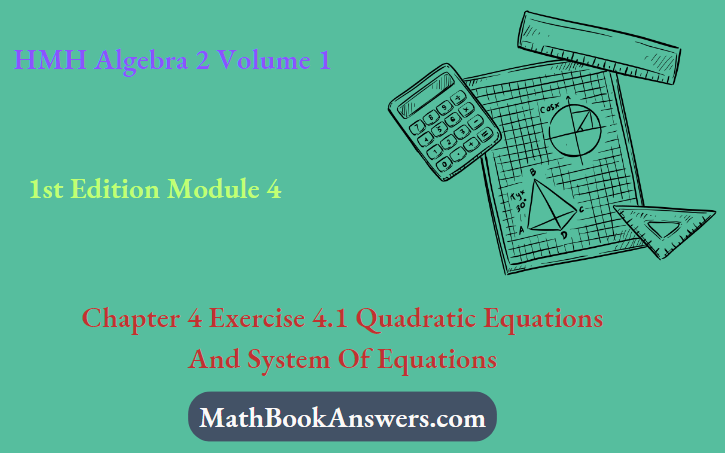
Page 158 Problem 3 Answer
It is given an equation 3x+2(x−1)=28
It is required to solve the equation to find the value of x.
To solve the given equation, perform the basic calculation to get the value of x.
It is given an equation 3x+2(x−1)=28
To get the value of x from equation 3x+2(x−1)=28.
Firstly, use distributive property 3x+2(x−1)=28
3x+2x−2=28
On further calculations equation becomes,
5x−2=28
Adding 2 to both sides,
5x−2+2=28+2
5x=30
Dividing both side by 5,
5x/5=30/5
x=6
For the equation 3x+2(x−1)=28,
x=6.
Page 158 Problem 4 Answer
It is given two equations
5x−2y=4
3x+2y=−12
It is required to find the value of x and y for given equations.
To solve this, find the value of y from first equation then put this value of y in second equation.
Then, solve the obtained equations by using basic calculations to get the value of x and y.
It is given two equations
5x−2y=4…….eq(1)
3x+2y=−12…….eq(2)
From eq(1)
y=5x−4/2
Substituting the value of y from eq(1) on eq(2),
3x+2(5x−4/2)=−12
3x+5x−4=−12
8x−4=−12
Adding 4 on both sides,
8x−4+4=−12+4
8x=−8
Dividing both side by 8,
8x/8=−8/8
x=−1
Substituting the obtained value of x in y=5x−4/2
y=5⋅(−1)−4/2
y=−5−4/2
y=−9/2
For the given equations the value of x and y are x=−1
y=−9/2
So, the solution of equation is (−1,−9/2).
Page 159 Problem 5 Answer
It is required to find the standard equation of circle.
The standard equation of circle is (x−h)2+(y−k)2=r2.
Standard equation of circle gives the idea of the centre and radius of the circle.
In the above equation (h,k) is the centre of circle and r is the radius of the circle.
The standard equation of circle is (x−h)2+(y−k)2=r2.
Standard equation of circle gives the idea of the centre and radius of the circle.
In the above equation (h,k) is the centre of circle and r is the radius of the circle.
HMH Algebra 2 Volume 1 Module 4 Chapter 4 Exercise 4.1 solutions
HMH Algebra 2 Volume 1 1st Edition Module 4 Chapter 4 Exercise 4.1 Quadratic Equations And System Of Equations Page 159 Problem 6 Answer
It is given a circle with centre C(h,k) and radius r.
It is given P(x,y) an arbitrary point on the given circle and another point A(x,k) which have same x−coordinate with P and same y−coordinate as C.
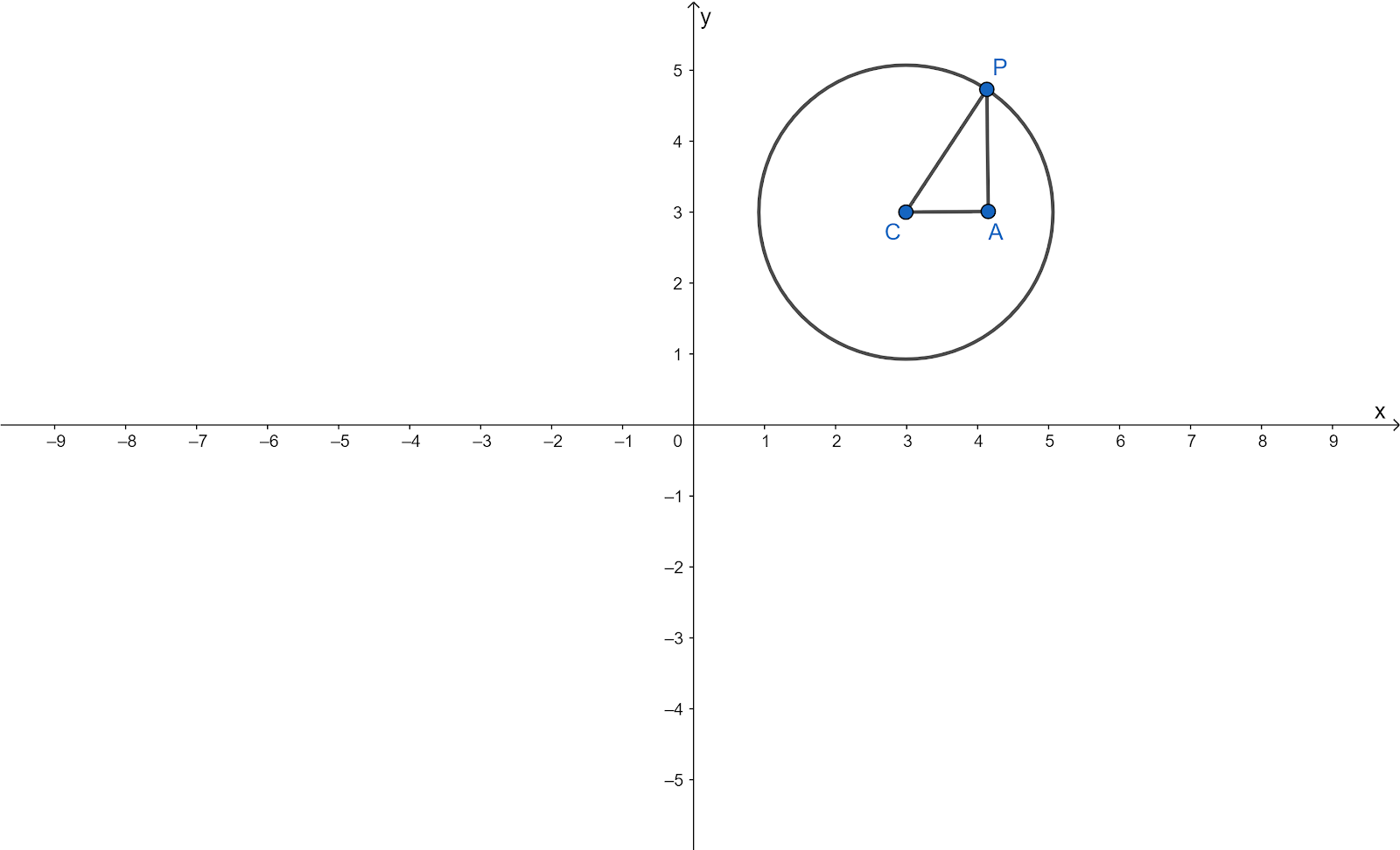
It is required to show that Δ CAP is right angle triangle.
Given circle have centre C(h,k) and radius r.
Given P(x,y) an arbitrary point on the given circle and another point A(x,k) which have same x−coordinate with P and same y−coordinate as C.
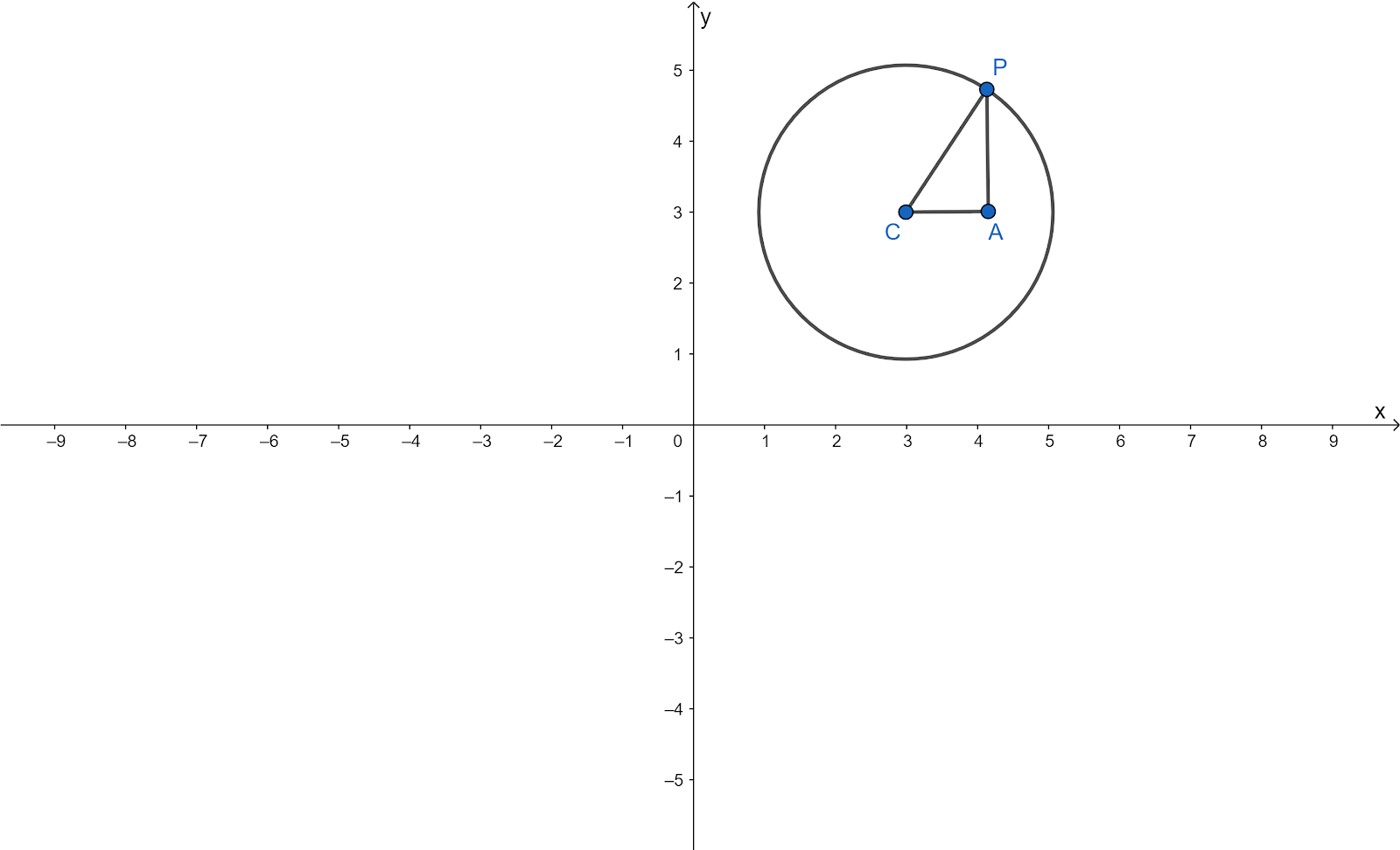
Taking the slope of CA,
m1=k−k/h−x
m1=0/h−x
m1=0
So, CA is parallel to x−axis.
Taking the slope of PA,
m2=y−k/x−x
m2=y−k/0
m2=∞
So, PA is parallel to y−axis.
Also x−axis and y−axis are perpendicular to each other. So, ΔCAP is right angle triangle having right angle at A.
ΔCAP is right angle triangle having right angle at A.
Page 159 Problem 7 Answer
It is given a circle with centre C(h,k) and radius r.
It is given P(x,y) an arbitrary point on the given circle and another point A(x,k) which have same x−coordinate with P and same y−coordinate as C.

It is required to find the length of sides AC, AP, and CP.
To solve this use distance formula to find the length of sides AC,AP and CP.
Given circle have centre C(h,k) and radius r.
Given P(x,y) an arbitrary point on the given circle and another point A(x,k) which have same x−coordinate with P and same y−coordinate as C.
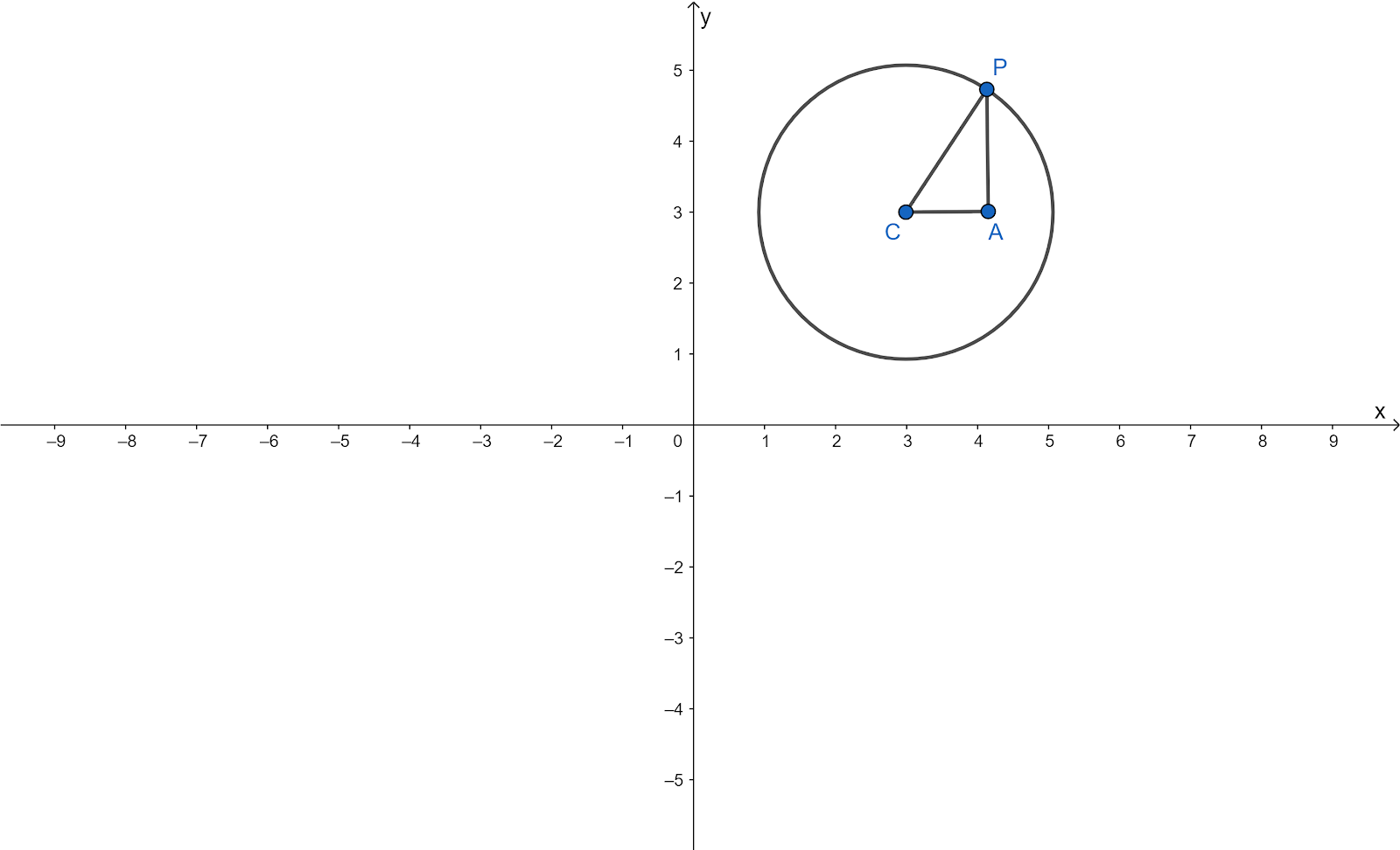
Now, length of AC is AC=√(h−x)2+(k−k)2
AC=√(h−x)2
AC=(h−x)
Now, length of AP is AP=√(x−x)2+(y−k)2
AP=√(y−k)2
AP=(y−k)
Now, length of CP
CP=√(x−h)2+(y−k)2
CP=√r2
CP=r
Length of AC is, AC=(h−x)
Length of AP is, AP=(y−k)
Length of CP is,
CP=r.
HMH Algebra 2 Volume 1 1st Edition Module 4 Chapter 4 Exercise 4.1 Quadratic Equations And System Of Equations Page 159 Problem 8 Answer
It is given a circle with centre C(h,k) and radius r.
It is given P(x,y) an arbitrary point on the given circle and another point A(x,k) which have same x−coordinate with P and same y−coordinate as C.
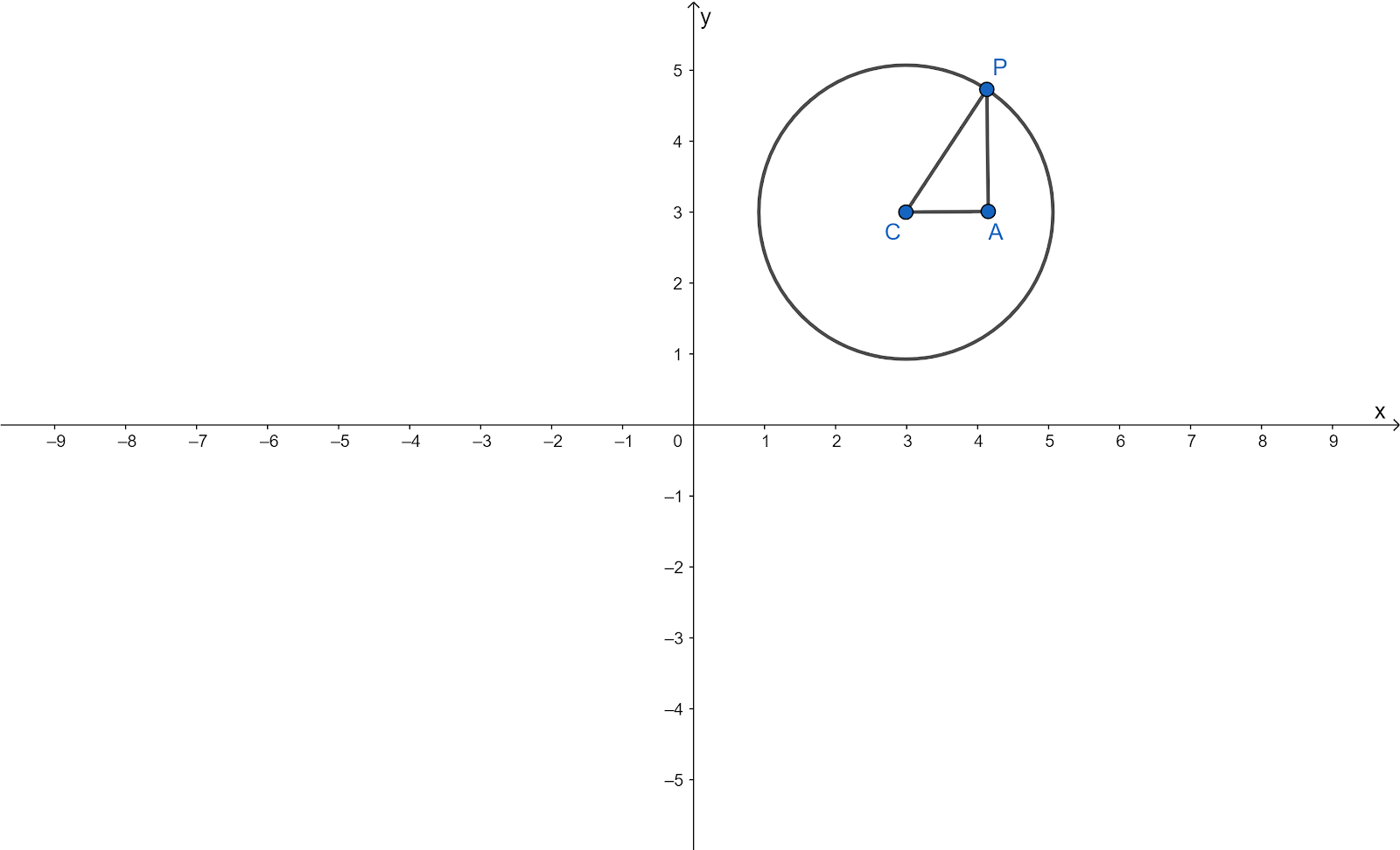
It is required to find the equation of circle by using Pythagoras theorem on Δ CAP.
To solve this use distance formula to find the length of sides AC,AP and CP.
Then use Pythagoras theorem on Δ CAP
Given circle have centre C(h,k) and radius r.
Given P(x,y) an arbitrary point on the given circle and another point A(x,k) which have same x−coordinate with P and same y−coordinate as C.
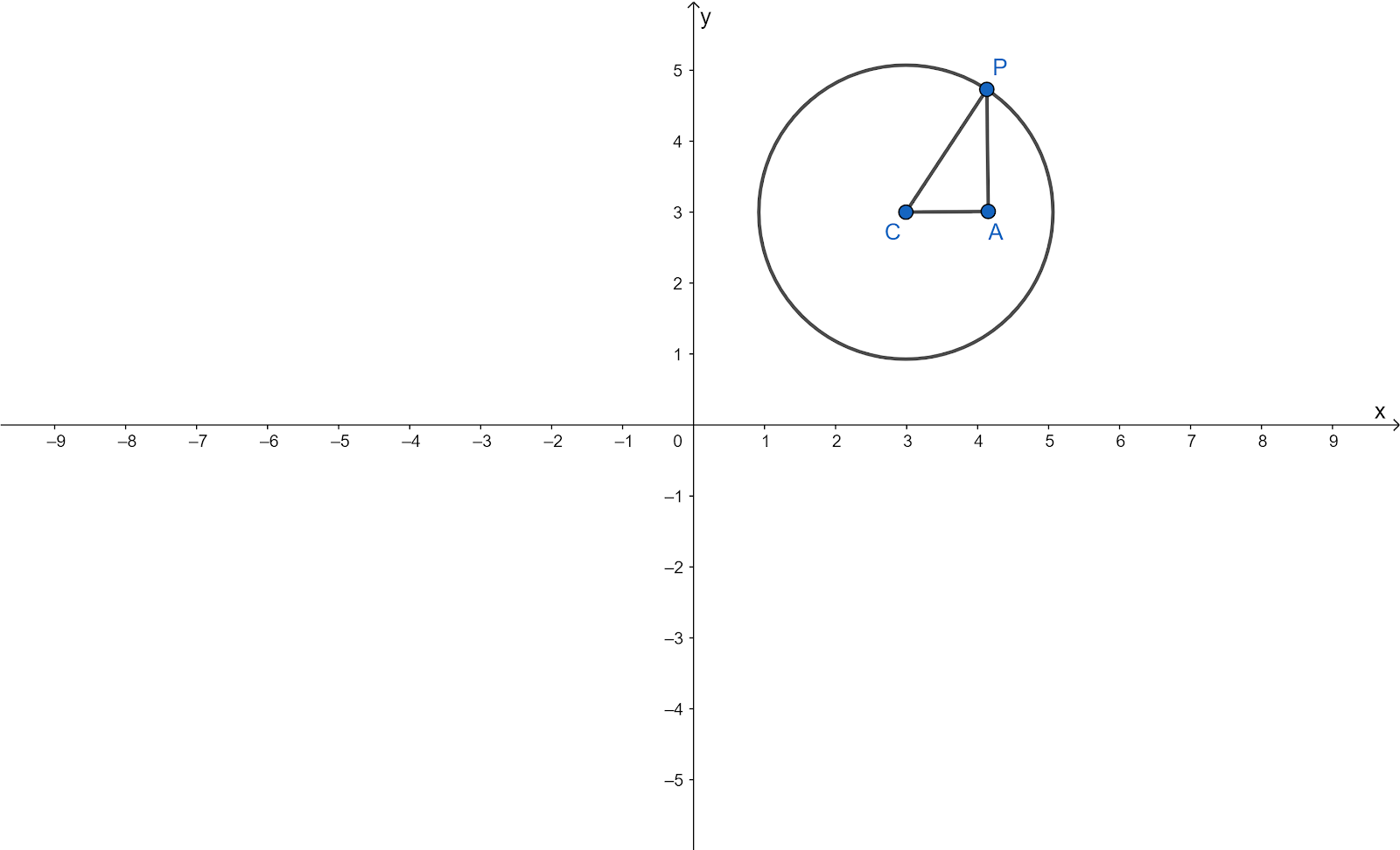
Now, length of AC is AC=√(h−x)2+(k−k)2
AC=√(h−x)2
AC=(h−x)
Now, length of AP is AP=√(x−x)2+(y−k)2
AP=√(y−k)2
AP=(y−k)
Now, length of CP is CP=√(x−h)2+(y−k)2
CP=√r2
CP=r
Applying Pythagoras theorem on Δ CAP.
AC2+AP2=CP2
Substituting the value of length of sides,
(h−x)2+(y−k)2=r2
Equation of circle will be,(h−x)2+(y−k)2=r2.
Page 160 Problem 9 Answer
It is required to prove that why isn’t absolute value used in the equation of the circle.
The general equation of a circle is (x−h)2+(y−k)2=r2, here all the terms are squared, and squared number is always a positive number.
Therefore, the absolute value function is not needed here because the terms here are already positive.
The absolute value function is not needed here because the terms here are already positive.
Page 160 Problem 10 Answer
It is required to show that why does the equation of the circle also apply to the cases in which P has the same x− coordinate as C or same y− coordinate as C so that Δ CAP doesn’t exist.
To equation of the circle will apply independent of ΔCAP as when the x− coordinate of P is that of C.
Then the point P will be directly above C such that Δy that is the difference in their y− coordinate of P is that of C.
After that the point P will be on the right of C
such that Δx that is difference in their x− coordinate will be equal to the radius of the circle.
The equation of the circle will apply independent of ΔCAP because in both cases the points cases the point P will be r unit away from C.
HMH Algebra 2 Volume 1 1st Edition Module 4 Chapter 4 Exercise 4.1 Quadratic Equations And System Of Equations Page 161 Problem 11 Answer
It is given a circle with center C(1,−4)
and radius r=2.
It is required to find the equation of given circle.
To solve this substitute the point of centre in place of (h,k) and value of radius in place of r in standard equation of circle.
Substitute the value of center C(1,−4) and radius r=2 on equation,(x−h)2+(y−k)2=r2
(x−1)2+(y−(−4))2=22
(x−1)2+(y+4)2=4
So, the equation of circle is,(x−1)2+(y+4)2=4
The equation of the circle is,(x−1)2+(y+4)2=4.
Page 161 Problem 12 Answer
It is given a circle with center C(−2,5) and passes through point P(−2,−1).
It is required to find the equation of given circle.
To solve this, firstly find the value of radius which is equal to the distance between center C(−2,5) and point P(−2,−1).
Then substitute the point of centre in place of (h,k) and value of radius In place of r in standard equation of circle.
Given circle has center C(−2,5) and passes through point P(−2,−1).
Distance between C(−2,5) and P(−2,−1) is CP=√(−2−5)2+(−1+2)2
CP=√72+12
CP=√49+1
CP=√50
Also, CP=r
So, r=√50
Substituting the value of center C(−2,5) and radius r=√50 on equation,
(x−h)2+(y−k)2=r2
(x−(−2))2+(y−5)2=(√50)2
(x+2)2+(y−5)2=50
Equation of circle is,(x+2)2+(y−5)2=50.
Page 162 Problem 13 Answer
It is given equation of a circle x2+y2+4x+6y+4=0.
It is required to graph the circle after writing the equation in standard form.
To solve this, convert the given equation to the standard form. Then plot the circle on the graph.
The given circle has equation x2+y2+4x+6y+4=0.
To convert the equation to standard form complete square method is used
(x2+2⋅2⋅x+22)+(y2+2⋅3⋅x+32)+4−4−9=0
(x2+4x+4)+(y2+6x+9)+(−9)=0
(x2+4x+4)+(y2+6x+9)=9
(x+2)2+(y+3)2
=32
So, the equation of circle is,
(x+2)2
+(y+3)2
=32
This circle has centre (−2,−3) and radius r=3.
Now plotting the circle on graph,
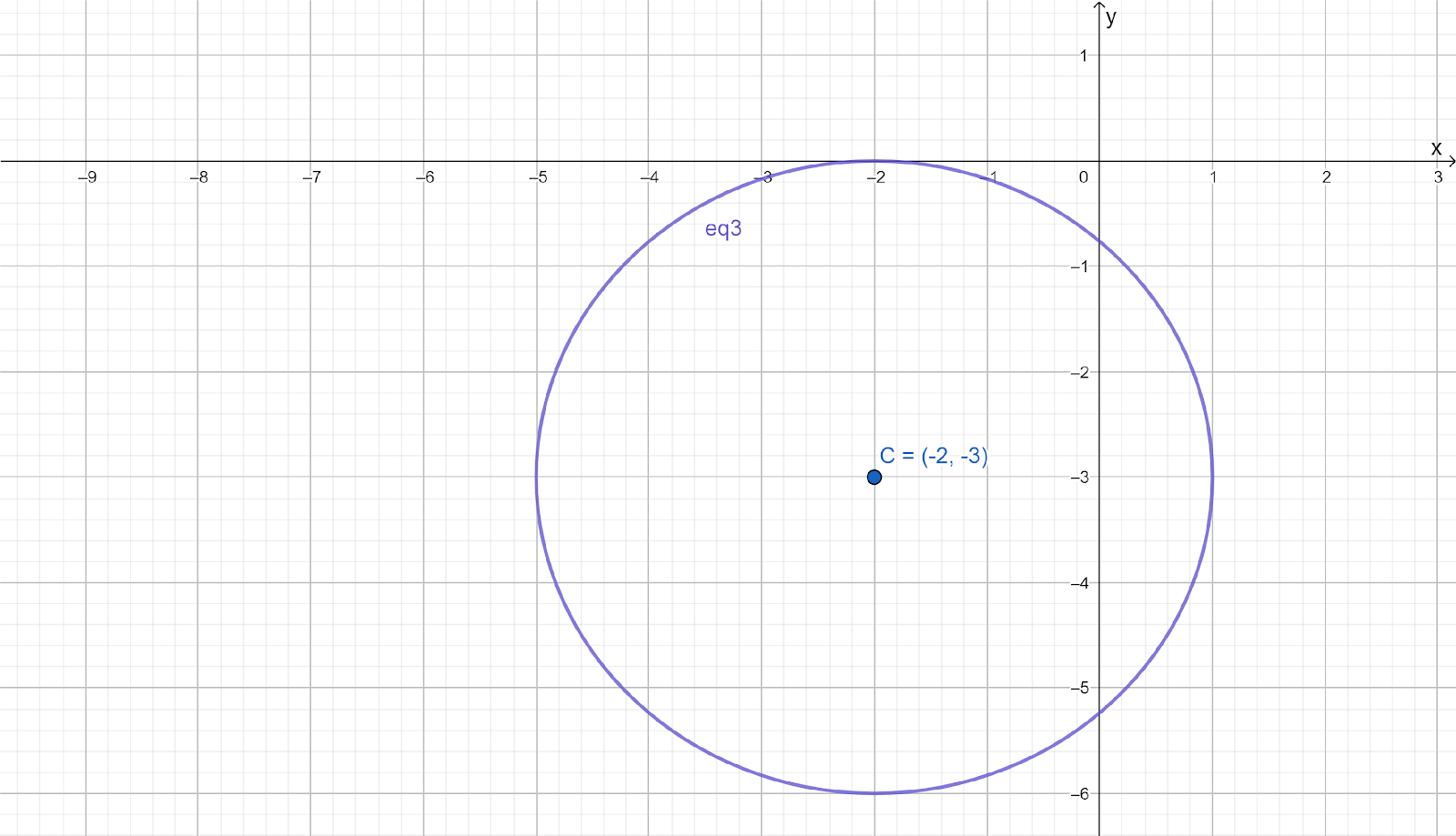
He equation of circle is,
(x+2)2
+(y+3)2
=32
Graph of the circle is,

Page 162 Problem 14 Answer
It is given equation of a circle 9x2+9y2−54x−72y+209=0.
It is required to graph the circle after writing the equation in standard form.
To solve this, write the equation of circle in general form then convert the given equation to the standard form. Then plot the circle on the graph.
The given circle has equation 9x2+9y2−54x−72y+209=0.
Divide the equation by 9,
9/9x2+9/9y2−54/9x−72/9y+209/9=0
x2+y2−6x−8y+209/9=0
To convert the equation to standard form complete square method is used
(x2−2⋅3⋅x+32)+(y2−2⋅4⋅x+42)+209/9−9−16=0
(x2−6x+9)+(y2−8x+16)−16/9=0
(x−3)2+(y−4)2=16/9
(x−3)2+(y−4)2=(4/3)2
So, the equation of circle is,
(x−3)2+(y−4)2=(4/3)2
Now plotting the circle on graph,
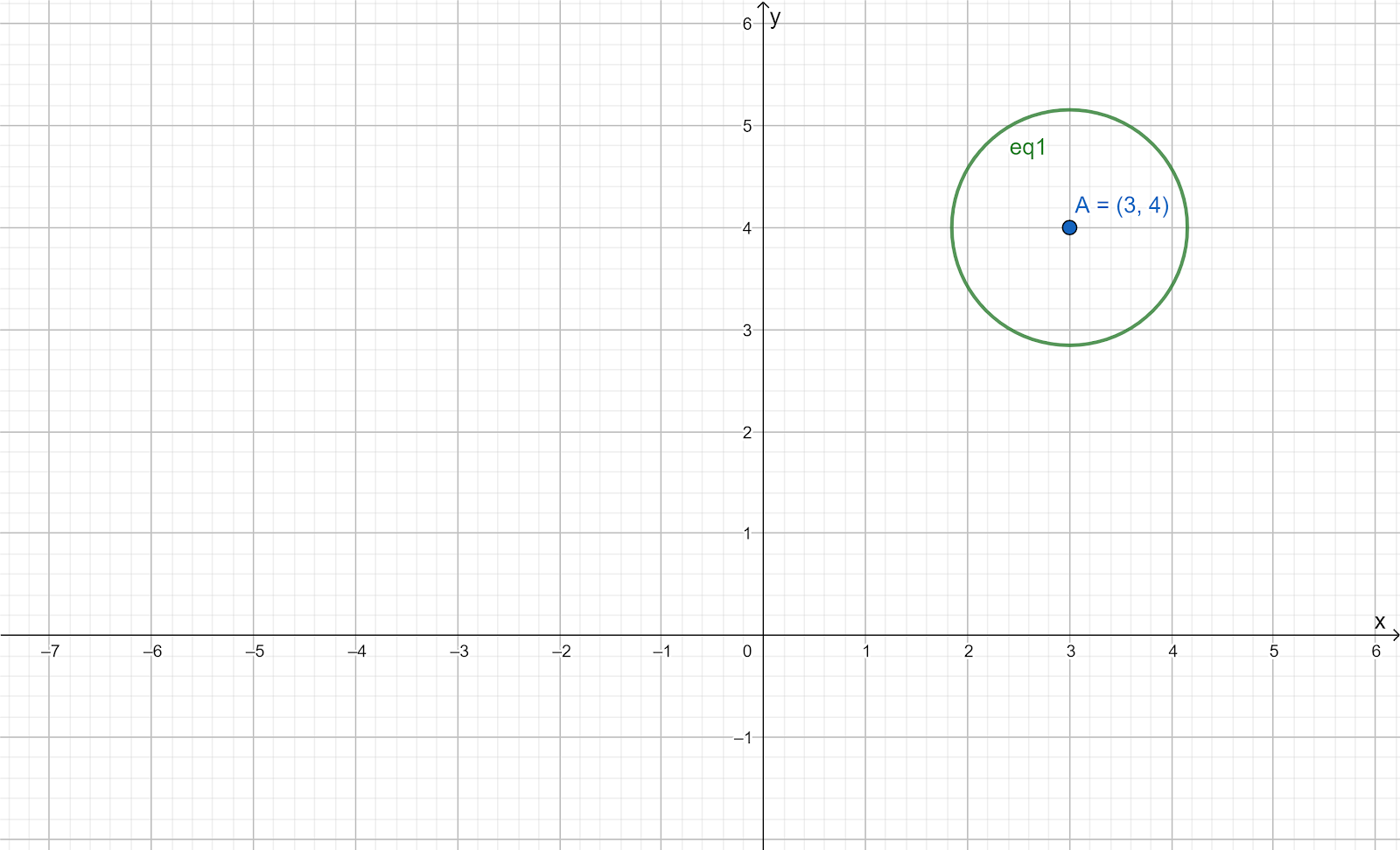
The equation of circle is,(x−3)2+(y−4)2=(4/3)2
Graph of the circle is,

Page 164 Problem 15 Answer
It is given that Sasha delivers newspapers that live within a 4- block radius of her house. Her house is located at point (0,−1) as shown in the graph below.
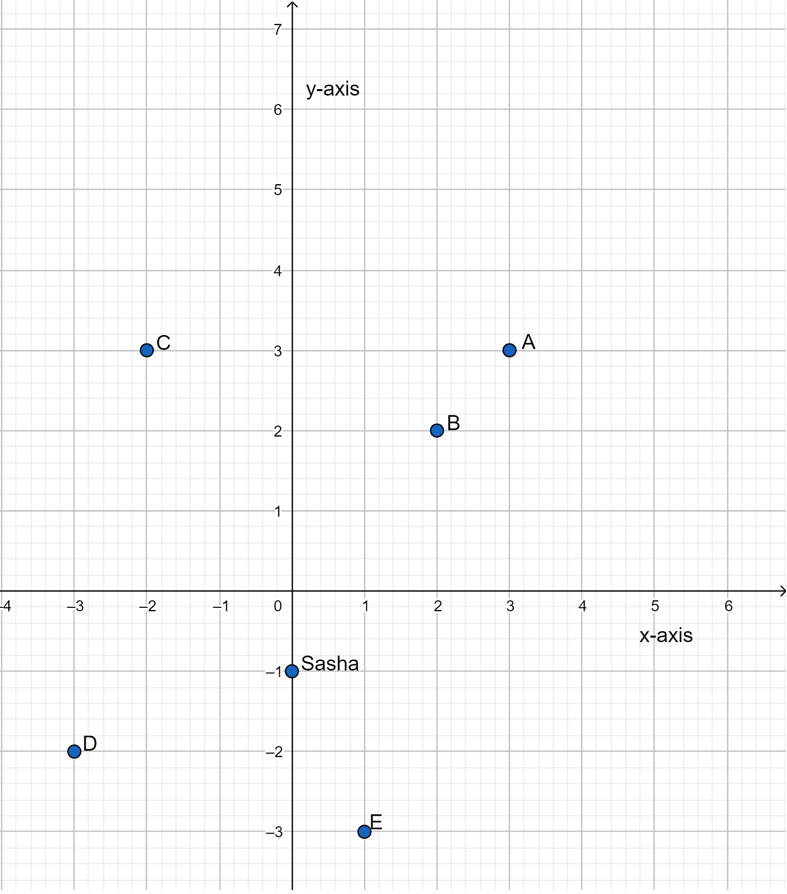
It is required to determine which houses does Sasha deliver newspapers.
This can be done by finding the inequality by using the equation of circle then make a graph of the required area.
Find the equation of circle by substituting the values in the general equation.
Substitute h=0,k=−1 andr=4 in the equation of circle
(x−h)2+(y−k)2=r2.
(x−0)2+(y−(−1))2=42
Now simplify.
(x)2+(y+1)2=16
Since she delivers newspapers to subscribers within a 4-mile radius; the required inequality becomes:
(x)2+(y+1)2<16
Graph the inequality and the points.
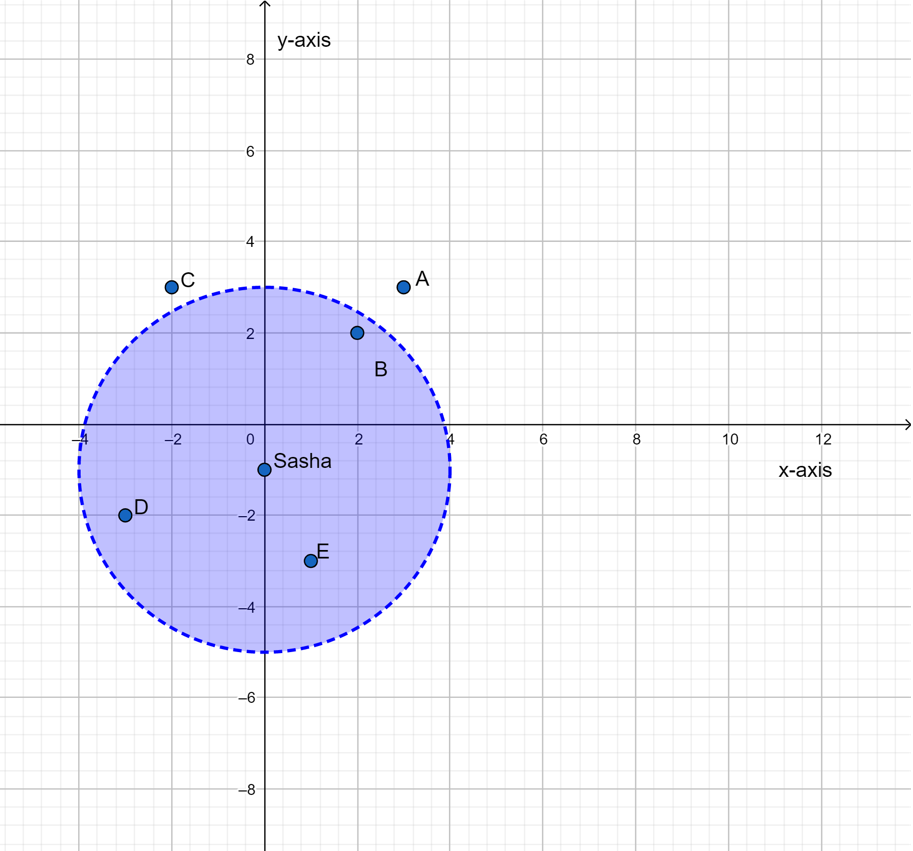
It can be seen that Sasha can only deliver newspaper to subscriber at points B,D and E.
The inequality will be x2+(y+1)2<16.
Sasha can only deliver newspaper to subscriber at points B,D and E.
HMH Algebra 2 Module 4 Chapter 4 Exercise 4.1 Quadratic Equations and Systems of Equations answers
HMH Algebra 2 Volume 1 1st Edition Module 4 Chapter 4 Exercise 4.1 Quadratic Equations And System Of Equations Page 164 Problem 16 Answer
It is given an equation ax2+ay2+cx+dy+e=0.
It is required to do something in order to graph it.
This can be done by forming the equation of a circle by using the completing the square method.
The general equation of the circle shows that both the x2 and y2 terms have a coefficient of 1.
⇒ \(\left(x^2+2 x\left(\frac{c}{2 a}\right)\right)+\left(y^2+2 y\left(\frac{d}{2 a}\right)\right)=-e\)
⇒ \(\left(x^2+2 x\left(\frac{c}{2 a}\right)+\left(\frac{c}{2 a}\right)^2\right)+\left(y^2+2 y\left(\frac{d}{2 a}\right)+\left(\frac{d}{2 a}\right)^2\right)=-e+\left(\frac{c}{2 a}\right)^2+\left(\frac{d}{2 a}\right)^2\)
⇒ \(\left(x+\frac{c}{2 a}\right)^2+\left(y+\frac{d}{2 a}\right)^2=-e+\frac{c^2}{4 a^2}+\frac{d^2}{4 a^2}\)
⇒ \(\left(x+\frac{c}{2 a}\right)^2+\left(y+\frac{d}{2 a}\right)^2=\frac{c^2+d^2-4 a^2 e}{4 a^2}\)
Therefore, the equation of the circle will be: x2+c/ax+y2+d/a y=−e
Now apply completing the square method to write it in a form comparable with the general equation.
The center of this circle lies on (h,k)=(−c2a,−d2a) and the radius r of the circle is equal to √c2+d2−4a2e/4a2.
Page 165 Problem 17 Answer
It is given the center (−4,−3) of the circle containing the point P(2,5).
It is required to write the equation of the circle.
This can be done by finding the radius the circle by using the distance formula then use general form of the circle to write the equation.
Calculate the radius by using the distance formula.
r=CP
=√(2−(−4))2+(5−(−3))2
=√(6)2+(8)2
=√36+64
=√100
=10
Write the equation of the circle by using the general form of the circle.
Substitute h=−4,k=−3, and r=10 in the equation (x−h)2+(y−k)2=r2.
(x−(−4))2+(y−(−3))2=(10)2
(x+4)2+(y+3)2=(10)2.
The required of the circle is (x+4)2+(y+3)2=(10)2.
Page 164 Problem 18 Answer
It is given an equation 4x2+4y2+8x−16y+11=0.
It is required to write the general equation of the circle and then graph the circle.
This can be done by converting the given equation into the general form of the circle then graph the circle by determining the centre and radius of circle.
Convert the equation 4x2+4y2+8x−16y+11=0 into the general form of the circle.
4x2+4y2+8x−16y+11=0
4(x2+2x)+4(y2−4y)+11=0
4(x2+2x+12)+4(y2−4y+(2)2)=−11+4(12)+4(22)4(x+1)2+4(y−2)2=9
(x+1)2+(y−2)2=9/4
(x+1)2+(y−2)2=(3/2)2
Thus, the general equation of the circle is (x+1)2+(y−2)2=(3/2)2.
The centre of the circle is C=(−1,2) and the radius of the circle is equal to r=3/2.
Now graph the circle.
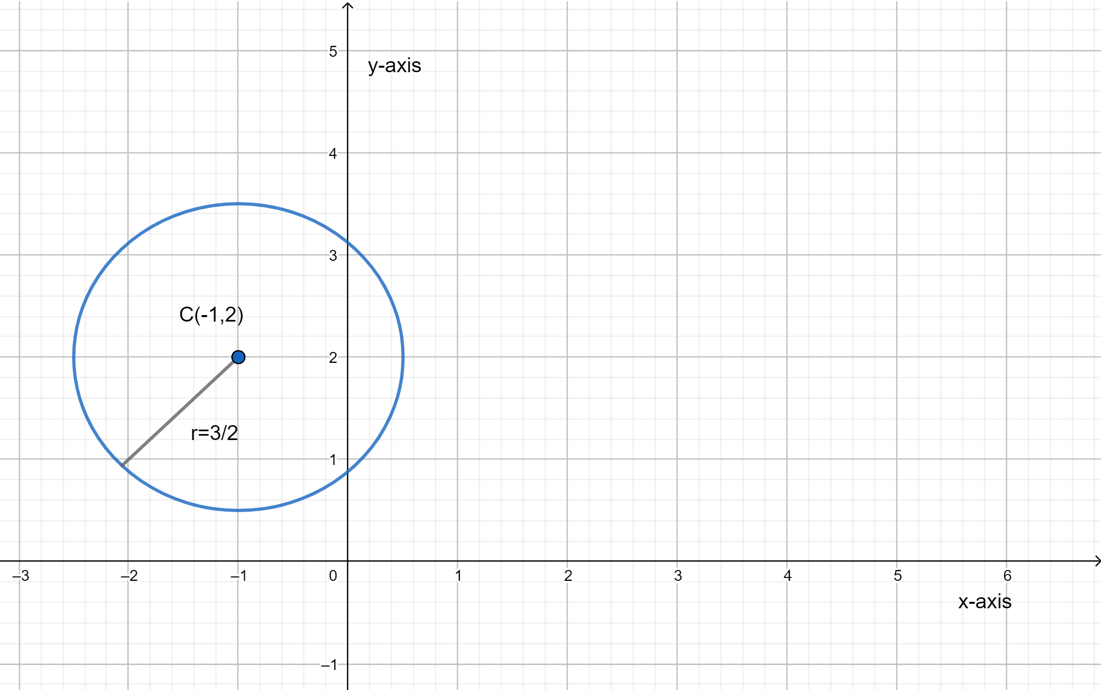
The general equation of the circle is (x+1)2+(y−2)2=(3/2)2 and it can be shown as:

Page 164 Problem 19 Answer
It is given the locations of the homes of five friends, a pizza restaurant, and the school they attend. It is also given that in order to ride the bus to school, the student must live more than 2
miles from the school.
It is required to write an inequality representing the given situation and draw a circle to solve the problem.
This can be done by writing the genera; form of the circle then according to the given condition set the inequality then plot the circle with the given locations.
Write the equation of the circle with center (1,−2) and radius r=2.
Substitute h=1,k=−2 and r=2 in the equation (x−h)2+(y−k)2=r2.
(x−1)2+(y−(−2))2=22
(x−1)2+(y+2)2=4.
Now write the inequality which represents the given situation.
As the locations must be greater than 2 miles in order to ride a bus to school. So, the inequality will be:
(x−1)2+(y+2)2>4
The required graph will be drawn like:

In the graph shown above, the shaded region represents the required area.
The points A,B,C are outside the circle satisfy the inequality.
Alonzo, Barbara, and Constance are eligible to ride the bus.
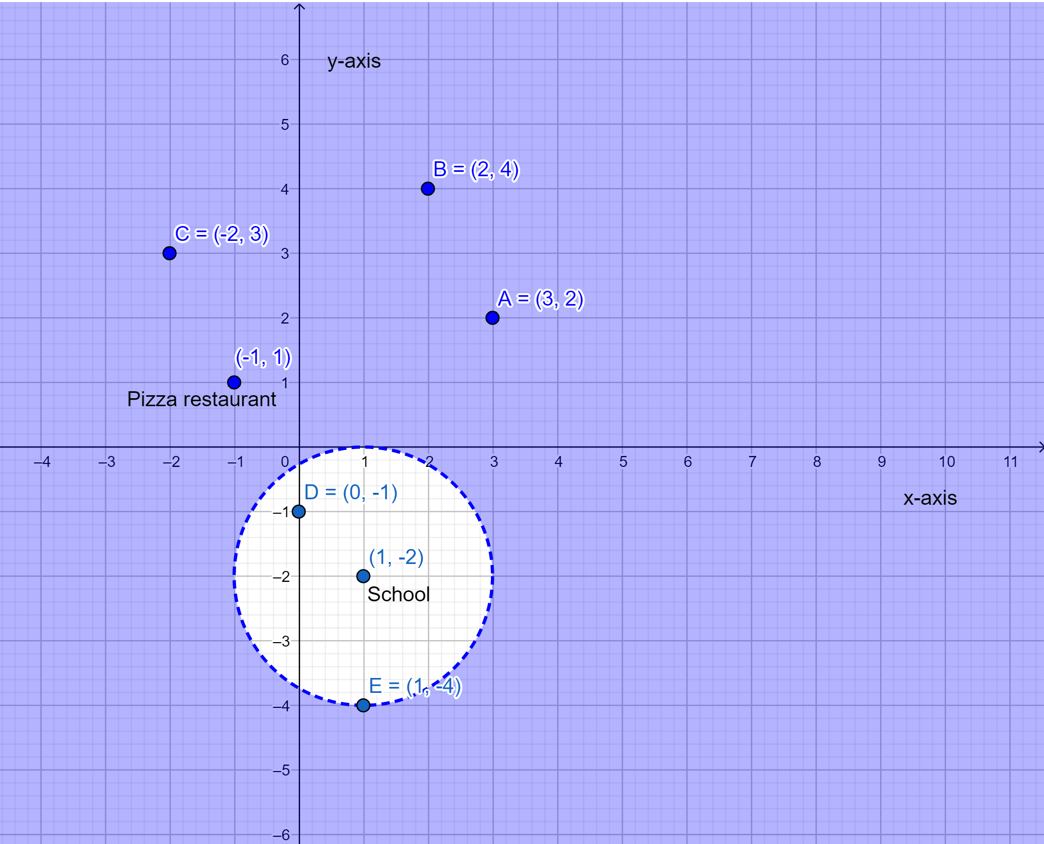
Page 165 Exercise 1 Answer
It is given the center (−7,−1) of a circle and its radius is equal to 13.
It is required to write the equation of the circle.
This can be done by using the standard equation of the circle.
We have to substitute r=13,h=−7 and k=−1 in the equation
(x−h)2+(y−k)2=r2.
(x+7)2+(y+1)2=132
(x+7)2+(y+1)2=169
The equation of the circle is (x+7)2+(y+1)2=169.
HMH Algebra 2 Volume 1 1st Edition Module 4 Chapter 4 Exercise 4.1 Quadratic Equations And System Of Equations Page 165 Exercise 2 Answer
It is given that a circle is centred at (−8,2) and contains the point (−1,6).
It is required to find the equation of the circle.
To find the equation of the circle, substitute the given values in the formula (x−h)2+(y−k)2=(x1−h)2+(y1−k)2.
Simplify the equations by using the identity (a+b)2=a2+2ab+b2.
Substitute (−8,2) for (h,k), (−1,6) for (x1,y1) in the inequality (x−h)2+(y−k)2=(x1−h)2+(y1−k)2.
Simplify the equations by using the identity (a+b)2=a2+2ab+b2.
(x−(−8))2+(y−2)2=(−1−(−8))2+(6−2)2
(x+8)2+(y−2)2=(7)2+(4)2
x2+16x+64+y2−4y+4=49+16x2+16x+y2−4y+3=0
The equation of the circle centred at (−8,2) and containing the point (−1,6) is x2+16x+y2−4y+3=0.
Page 165 Exercise 3 Answer
It is given that a circle is centred at (5,9) and contains the point (4,8).
It is required to find the equation of the circle.
To find the equation of the circle, substitute the given values in the formula (x−h)2+(y−k)2=(x1−h)2+(y1−k)2.
Simplify the equations by using the identity (a+b)2=a2+2ab+b2.
We have to substitute (5,9) for (h,k), (4,8) for (x1,y1) in the inequality (x−h)2+(y−k)2=(x1−h)2+(y1−k)2.
Simplify the equations by using the identity (a+b)2=a2+2ab+b2.
(x−5)2+(y−9)2=(4−5)2+(8−9)2
x2−10x+25+y2−18y+81=(−1)2+(−1)2
x2−10x+y2−18y+(81+25)=1+1x2−10x+y2−18y+104=0
The equation of the circle centred at (5,9) and containing the point (4,8) is x2−10x+y2−18y+104=0.
Page 165 Exercise 4 Answer
The equation of a circle is given as x2+y2−2x−8y+13=0.
It is required to write the given equation in the standard form and then plot the graph of the circle.
To write the given equation in the standard form, i.e. (x−h)2+(y−k)2=r2, where (h,k) is the centre and r is the radius, obtain perfect squares for the x,y terms by addition necessary numbers on both sides of the equation and simplify to the standard form.
Then, plot the graph of the circle on a graphing calculator by using the standard form.
Write the given equation of the circle in the form (x−h)2+(y−k)2=r2.
The given equation of the circle can be written as x2−2x+1+y2−8y+16+13=1+16.
On simplifying the equation and making perfect squares for the x,y,terms,
(x2−2x+1)+(y2−8y+16)+13=1+16
(x−1)2+(y−4)2+13=17
(x−1)2+(y−4)2=4
(x−1)2+(y−4)2=22
This means that the radius of the circle r is 2 and the centre C is (1,4).
Plot the graph of the circle with equation (x−1)2+(y−4)2=22 by using a graphical calculator.
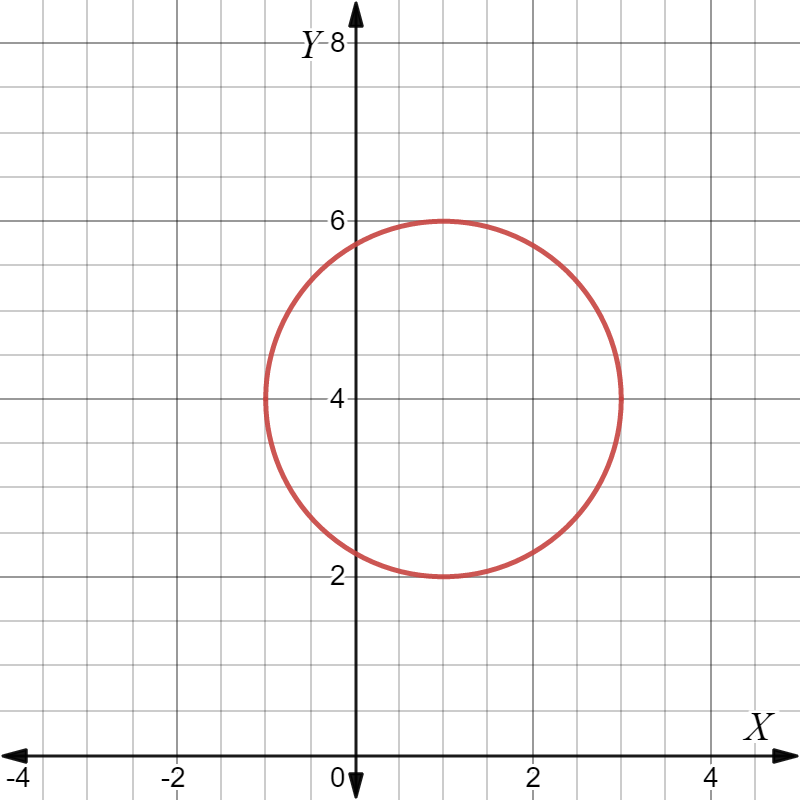
The equation of the given circle in the standard form is (x−1)2+(y−4)2=22.
The graph of the circle is shown below.
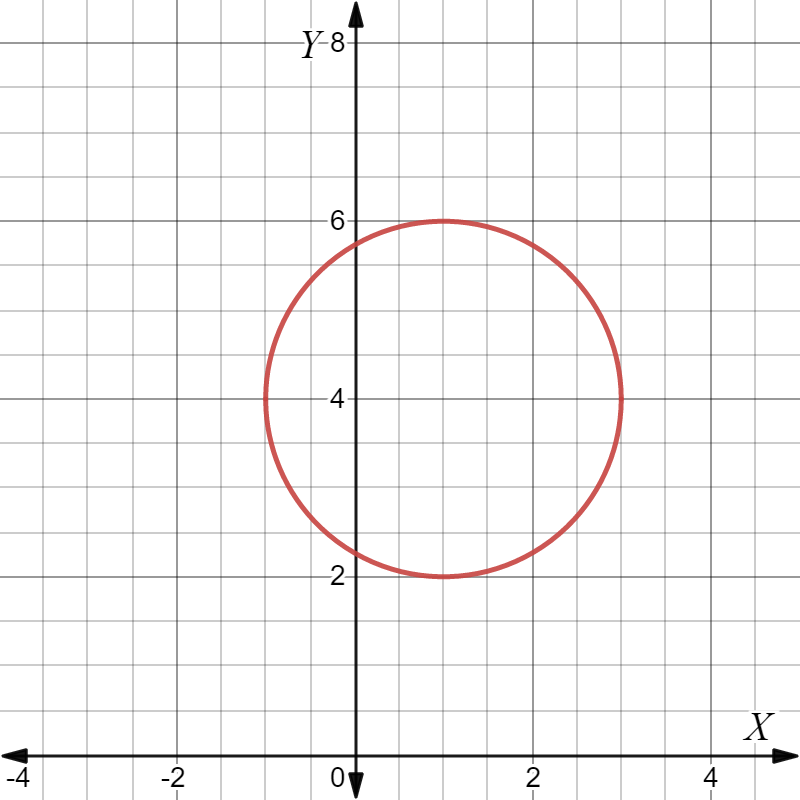
HMH Algebra 2 Volume 1 1st Edition Module 4 Chapter 4 Exercise 4.1 Quadratic Equations And System Of Equations Page 166 Exercise 5 Answer
The equation of a circle is given as x2+y2+6x−10y+25=0.
It is required to write the given equation in the standard form and then plot the graph of the circle.
To write the given equation in the standard form, i.e. (x−h)2+(y−k)2=r2, where (h,k) is the centre and r is the radius, obtain perfect squares for the x,y terms by addition necessary numbers on both sides of the equation and simplify to the standard form.
Then, plot the graph of the circle on a graphing calculator by using the standard form.
Write the given equation of the circle in the form (x−h)2+(y−k)2=r2.
The given equation of the circle can be written as x2+6x+9+y2−10y+25+25=9+25.
On simplifying the equation and making perfect squares for the x,y terms,
(x2+6x+9)+(y2−10y+25)+25=9+25(x−3)2+(y−5)2+25=34
(x−3)2+(y−5)2=9
(x−3)2+(y−5)2=32
This means that the radius of the circle r is 3 and the centre C is (3,5).
Plot the graph of the circle with equation (x−3)2+(y−5)2=32 by using a graphical calculator.
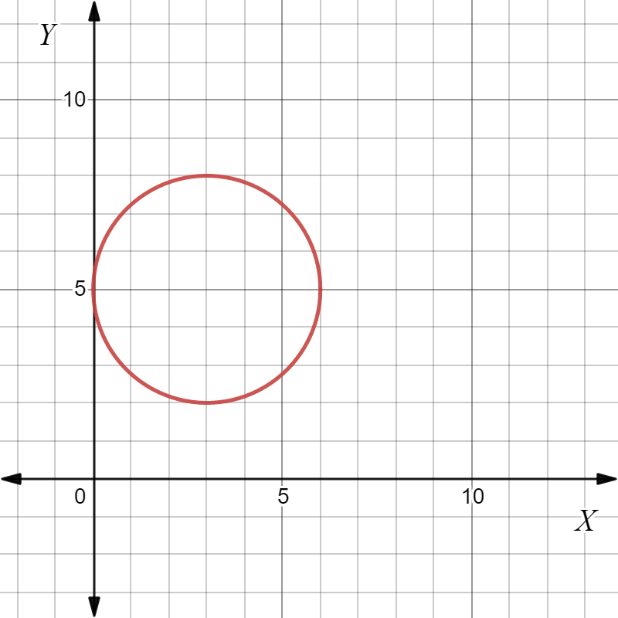
The equation of the given circle in the standard form is (x−3)2+(y−5)2=32.
The graph of the circle is shown below.
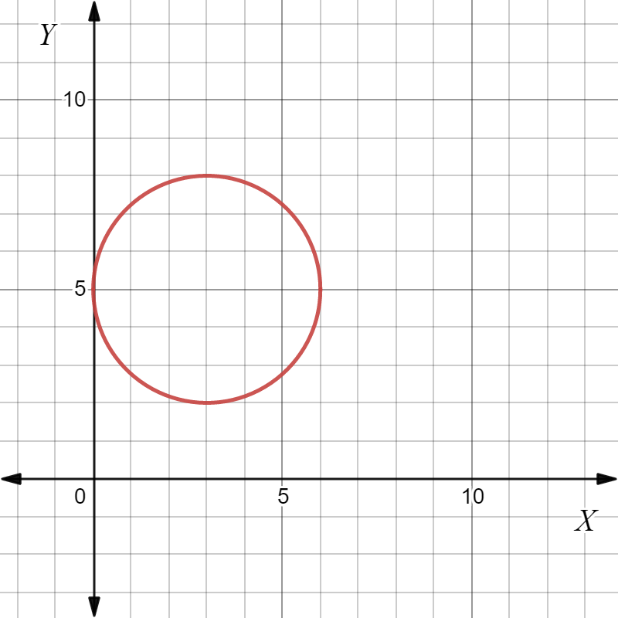
Page 166 Exercise 6 Answer
The equation of a circle is given as x2+y2+4x+12y+39=0.
It is required to write the given equation in the standard form and then plot the graph of the circle.
To write the given equation in the standard form, i.e. (x−h)2+(y−k)2=r2, where (h,k) is the centre and r is the radius, obtain perfect squares for the x,y terms by addition necessary numbers on both sides of the equation and simplify to the standard form.
Then, plot the graph of the circle on a graphing calculator by using the standard form.
Write the given equation of the circle in the form (x−h)2+(y−k)2=r2.
The given equation of the circle can be written as x2+4x+4+y2+12y+36+39=4+36.
On simplifying the equation and making perfect squares for the x,y terms,
(x2+4x+4)+(y2+12y+36)+39=4+36
(x+2)2+(y+6)2=40−39(x+2)2+(y+6)2=1
(x+2)2+(y+6)2=12
This means that the radius of the circle r is 1 and the centre C is (−2,−6).
Plot the graph of the circle with equation (x+2)2+(y+6)2=12 by using a graphical calculator.
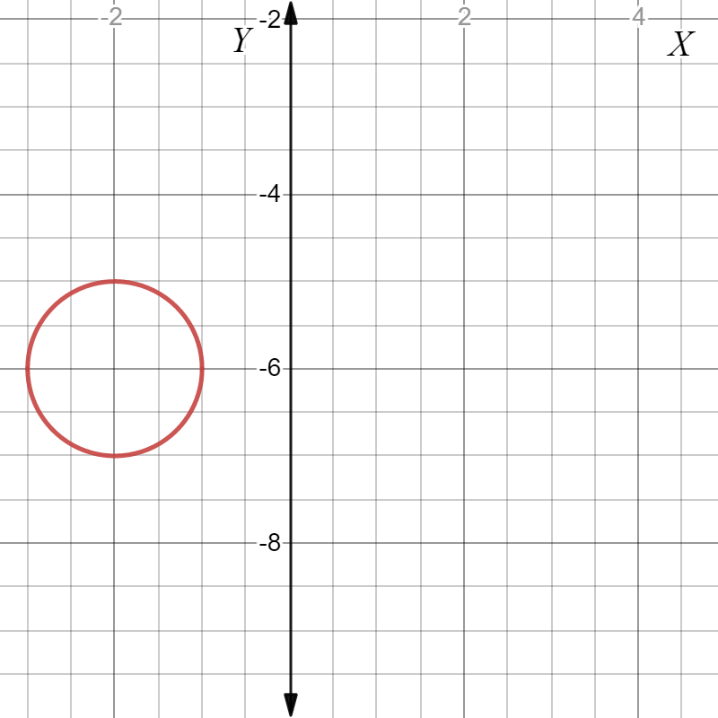
The equation of the given circle in the standard form is (x+2)2+(y+6)2=12.
The graph of the circle is shown below.
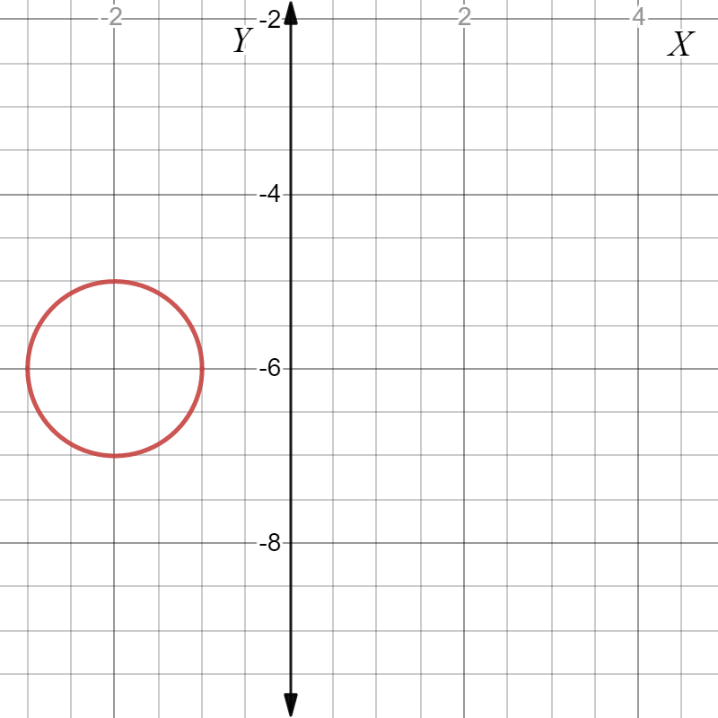
Page 166 Exercise 7 Answer
The equation of a circle is given as 8x2+8y2−16x+32y−88=0.
It is required to write the given equation in the standard form and then plot the graph of the circle.
Write the given equation of the circle in the form \((x-h)^2+(y-k)^2=r^2\).
Divide both sides of the equation \(8 x^2+8 y^2-16 x+32 y-88=0$ by eight.
⇒ [latex]\frac{8 x^2+8 y^2-16 x+32 y-88}{8}\)
⇒ \(x^2+y^2-2 x+4 y-11=0\)
The given equation of the circle can be written as \(x^2-2 x+1+y^2+4 y+4-11=1+4 \text {. }\)
On simplifying the equation and making perfect squares for the x, and y terms, \(\left(x^2-2 x+1\right)+\left(y^2+4 y+4\right)-11=5\)
⇒ \((x-1)^2+(y+2)^2=5+11\)
⇒ \((x-1)^2+(y+2)^2=16\)
⇒ \((x-1)^2+(y+2)^2=4^2\)
This means that the radius of the circle r is 4 and the centre C is (1,-2).
To write the given equation in the standard form, i.e. (x−h)2+(y−k)2=r2, where ( h,k ) is the centre and r is the radius, obtain perfect squares for the x,y terms by addition necessary numbers on both sides of the equation and simplify to the standard form.
Then, plot the graph of the circle on a graphing calculator by using the standard form.
Plot the graph of the circle with equation (x−1)2+(y+2)2=42 by using a graphical calculator.
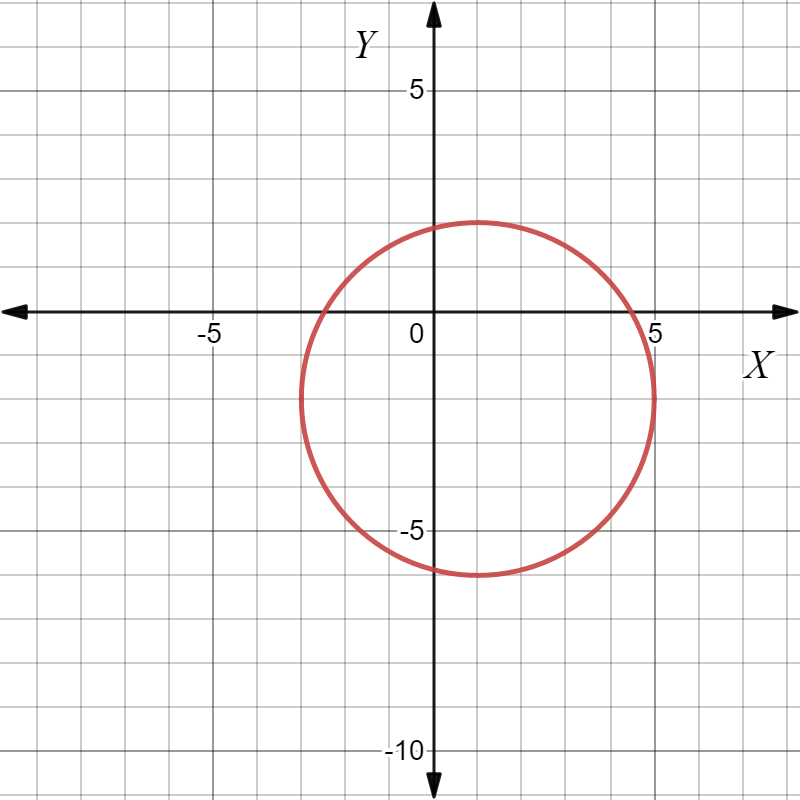
The equation of the given circle in the standard form is (x−1)2+(y+2)2=42.
The graph of the circle is shown below.
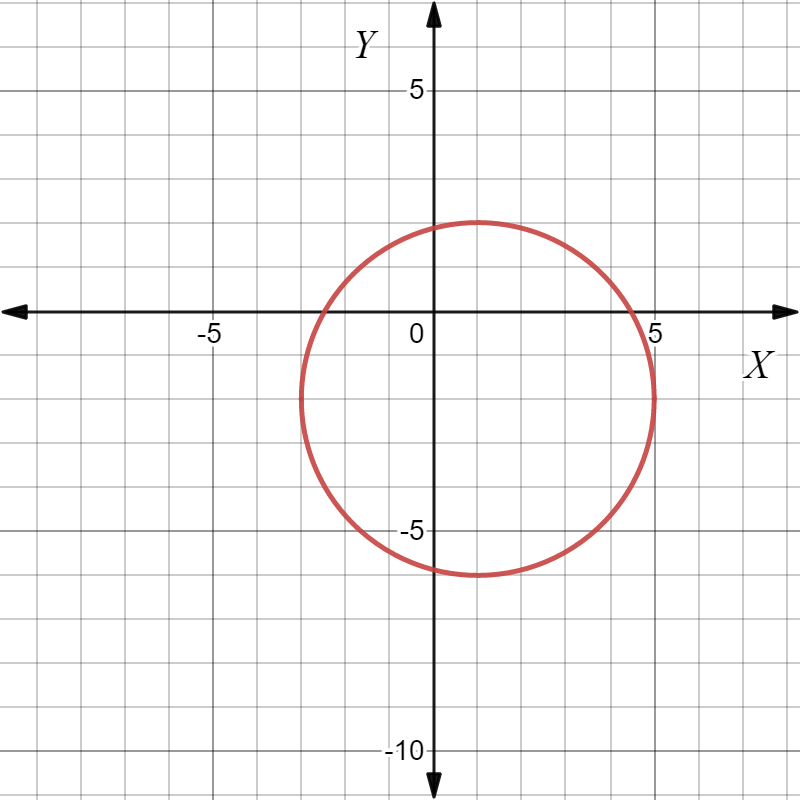
HMH Algebra 2 Chapter 4 Exercise 4.1 Quadratic Equations key
HMH Algebra 2 Volume 1 1st Edition Module 4 Chapter 4 Exercise 4.1 Quadratic Equations And System Of Equations Page 167 Exercise 8 Answer
The equation of a circle is given as 2x2+2y2+20x+12y+50=0.
It is required to write the given equation in the standard form and then plot the graph of the circle.
The given equation of the circle can be written as \(x^2+10 x+25+y^2+6 y+9+25=25+9 \text {. }\)
On simplifying the equation and making perfect squares for the x, and y terms,
⇒ \(\left(x^2+10 x+25\right)+\left(y^2+6 y+9\right)+25=34\)
⇒ \((x+5)^2+(y+3)^2=34-25\)
⇒ \((x+5)^2+(y+3)^2=9\)
⇒ \((x+5)^2+(y+3)^2=3^2\)
This means that the radius of the circle r is 3 and the centre C is (-5,-3).
Write the given equation of the circle in the form \((x-h)^2+(y-k)^2=r^2\).
Divide both sides of the equation \(2 x^2+2 y^2+20 x+12 y+50=0\) by two.
⇒ \(\frac{2 x^2+2 y^2+20 x+12 y+50}{2}=\frac{0}{2}\)
⇒ \(x^2+y^2+10 x+6 y+25=0\)
To write the given equation in the standard form, i.e. (x−h)2+(y−k)2=r2, where (h,k) is the centre and r is the radius, obtain perfect squares for the x,y terms by adding necessary numbers on both sides of the equation and simplify to the standard form.
Then, plot the graph of the circle on a graphing calculator by using the standard form.
Plot the graph of the circle with equation (x+5)2+(y+3)2=32 by using a graphical calculator.

The equation of the given circle in the standard form is (x+5)2+(y+3)2=32.
The graph of the circle is shown below,

Page 167 Exercise 9 Answer
The equation of a circle is given as 12x2+12y2−96x−24y+201=0.
It is required to write the given equation in the standard form and then plot the graph of the circle.
The given equation of the circle can be written as \(x^2-8 x+16+y^2-2 y+1+\frac{201}{12}=16+1 \text {. }\)
On simplifying the equation and making perfect squares for the x, and y terms,
⇒ \(\left(x^2-8 x+16\right)+\left(y^2-2 y+1\right)+\frac{201}{12}=17\)
⇒ \((x-4)^2+(y-1)^2=17-\frac{201}{12}\)
⇒ \((x-4)^2+(y-1)^2=\frac{204-201}{12}\)
⇒ \((x-4)^2+(y-1)^2=\left(\frac{1}{2}\right)^2\)
This means that the radius of the circle r is \(\frac{1}{2}\) and the centre C is (4,1).
Write the given equation of the circle in the form \((x-h)^2+(y-k)^2=r^2\). Divide both sides of the equation \(12 x^2+12 y^2-96 x-24 y+201=0\) by twelve.
⇒ \(\frac{12 x^2+12 y^2-96 x-24 y+201}{12}=\frac{0}{12}\)
⇒ \(x^2+y^2-8 x-2 y+\frac{201}{12}=0\)
To write the given equation in the standard form, i.e. (x−h)2+(y−k)2=r2, where (h,k) is the centre and r is the radius, obtain perfect squares for the x,y terms by addition necessary numbers on both sides of the equation and simplify to the standard form.
Then, plot the graph of the circle on a graphing calculator by using the standard form.
Plot the graph of the circle with equation (x−4)2+(y−1)2=(1/2)2 by using a graphical calculator.
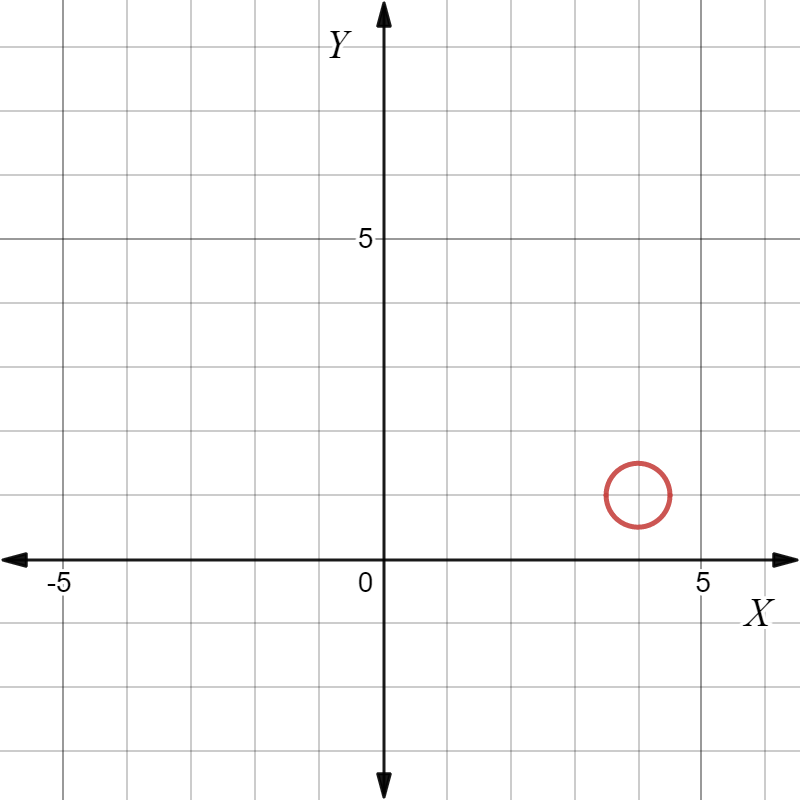
The equation of the given circle in the standard form is (x−4)2+(y−1)2=(1/2)2.
The graph of the circle is shown below.

Page 167 Exercise 10 Answer
The equation of a circle is given as 16x2+16y2+64x−96y+199=0.
It is required to write the given equation in the standard form and then plot the graph of the circle.
The given equation of the circle can be written as \(x^2+4 x+4+y^2-6 y+9+\frac{199}{16}=4+9 \text {. }\)
On simplifying the equation and making perfect squares for the x,y terms, \(\left(x^2+4 x+4\right)+\left(y^2-6 y+9\right)+\frac{199}{16}=13\)
⇒ \((x+2)^2+(y-3)^2=13-\frac{199}{16}\)
⇒ \((x+2)^2+(y-3)^2=\frac{9}{16}\)
⇒ \((x+2)^2+(y-3)^2=\left(\frac{3}{4}\right)^2\)
This means that the radius of the circle r is \(\frac{3}{4}\) and the centre C is (-2,3)
Write the given equation of the circle in the form \((x-h)^2+(y-k)^2=r^2\).
Divide both sides of the equation \(16 x^2+16 y^2+64 x-96 y+199=0\) by 16.
⇒ \(\frac{16 x^2+16 y^2+64 x-96 y+199=0}{16}=\frac{0}{16}\)
⇒ \(x^2+y^2+4 x-6 y+\frac{199}{16}=0\)
To write the given equation in the standard form, i.e. (x−h)2+(y−k)2=r2, where (h,k) is the centre and r is the radius, obtain perfect squares for the x,y terms by addition necessary numbers on both sides of the equation and simplify to the standard form.
Then, plot the graph of the circle on a graphing calculator by using the standard form.
Plot the graph of the circle with equation (x+2)2+(y−3)2=(3/4)2 by using a graphical calculator.
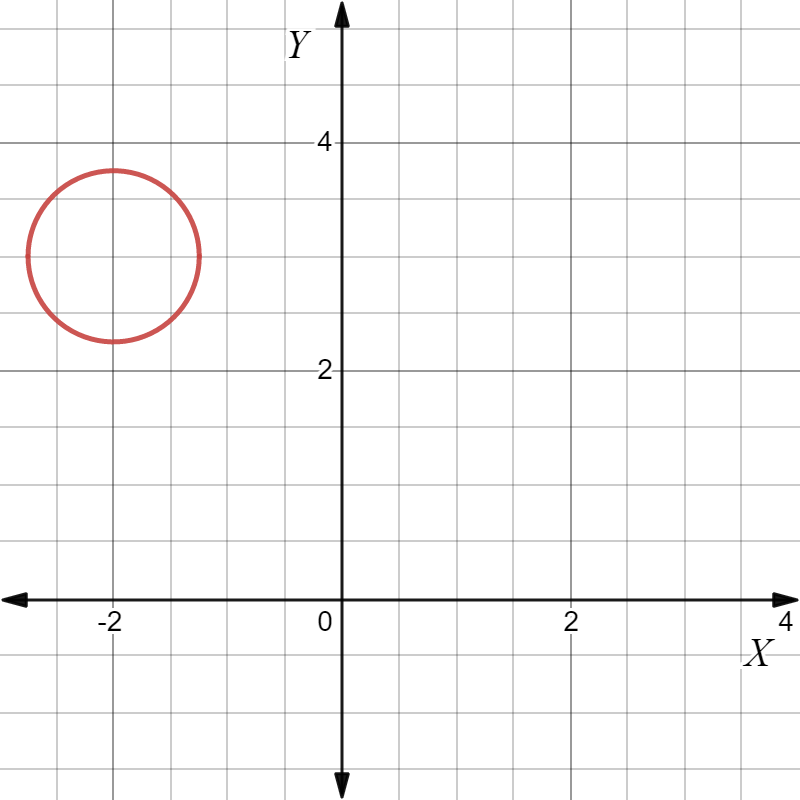
The equation of the given circle in the standard form is (x+2)2+(y−3)2=(3/4)2.
The graph of the circle is shown below.
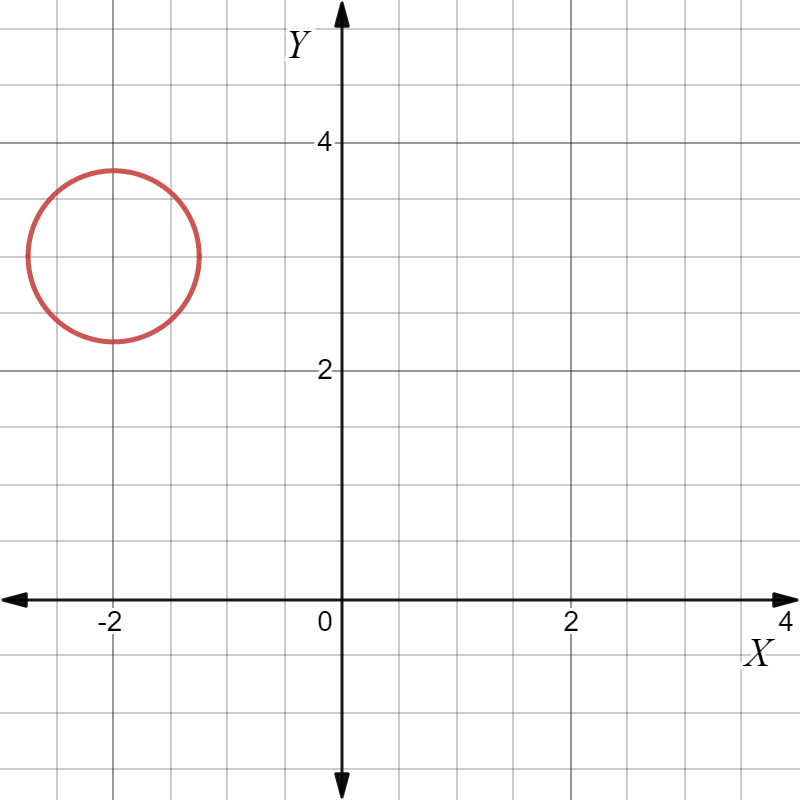
Page 170 Exercise 11 Answer
The equation of a circle is given as x2+18x+y2+22y−23=0.
It is required to find the radius and the coordinates of the centre.
To find the radius and the centre of the circle, write the given equation in the standard form, i.e. (x−h)2+(y−k)2=r2, where (h,k) is the centre and r is the radius.
Obtaining perfect square for the x,y terms by addition necessary numbers on both sides of the equation and simplify to the standard form.
Write the given equation of the circle in the form (x−h)2+(y−k)2=r2.
The given equation of the circle can be written as x2+18x+81+y2+22y+121−23=81+121.
On simplifying the equation and making perfect squares for the x,y terms,(x2+18x+81)+(y2+22y+121)−23=81+121
(x+9)2+(y+11)2−23=202
(x+9)2+(y+11)2=225
(x−(−9))2+(y−(−11))2=152
This means that the radius of the circle r is 15 and the centre C is (−9,−11).
The radius of the circle r is 15 and the centre C is (−9,−11).
HMH Algebra 2 Volume 1 1st Edition Module 4 Chapter 4 Exercise 4.1 Quadratic Equations And System Of Equations Page 170 Exercise 12 Answer
The equation of a circle is given as x2+y2−18x+22y+33=0.
It is required to find the radius and the coordinates of the centre.
To find the radius and the centre of the circle, write the given equation in the standard form, i.e. (x−h)2+(y−k)2=r2, where (h,k) is the centre and r is the radius.
Obtaining perfect square for the x,y terms by addition necessary numbers on both sides of the equation and simplify to the standard form.
Write the given equation of the circle in the form (x−h)2+(y−k)2=r2.
The given equation of the circle can be written as x2−18x+81+y2+22y+121+33=81+121.
On simplifying the equation and making perfect squares for the x,y terms, (x2−18x+81)+(y2+22y+121)+33=81+121
(x−9)2+(y+11)2+33=202
(x−9)2+(y+11)2=169
(x−9)2+(y−(−11))2=132
This means that the radius of the circle r is 13 and the centre C is (9,−11).
The radius of the circle r is 13 and the centre C is (9,−11).
Page 170 Exercise 13 Answer
The equation of a circle is given as 25x2+25y2−450x−550y−575=0.
It is required to find the radius and the coordinates of the centre.
The given equation of the circle can be written as \(x^2-18 x+81+y^2-22 y+121-23=81+121 \text {. }\)
On simplifying the equation and making perfect squares for the x, y terms, \(\left(x^2-18 x+81\right)+\left(y^2-22 y+121\right)-23=81+121[latex]
⇒ [latex](x-9)^2+(y-11)^2=202+23\)
⇒ \((x-9)^2+(y-11)^2=225\)
⇒ \((x-9)^2+(y-11)^2=15^2\)
This means that the radius of the circle r is 15 and the centre C is (9,11)
Write the given equation of the circle in the form \((x-h)^2+(y-k)^2=r^2\). Divide both sides of the equation \(25 x^2+25 y^2-450 x-550 y-575=0\) by 25 .
⇒ \(\frac{25 x^2+25 y^2-450 x-550 y-575}{25}=\frac{0}{25}\)
⇒ \(x^2+y^2-18 x-22 y-23=0\)
To find the radius and the centre of the circle, write the given equation in the standard form, i.e. (x−h)2+(y−k)2=r2, where (h,k) is the centre and r is the radius.
Obtaining perfect square for the x, and y terms by adding necessary numbers on both sides of the equation and simplifying to the standard form.
The radius of the circle r is 15 and the centre C is (9,11).
HMH Algebra 2 Volume 1 1st Edition Module 4 Chapter 4 Exercise 4.1 Quadratic Equations And System Of Equations Page 170 Exercise 14 Answer
The equation of a circle is given as 25x2+25y2+450x−550y+825=0.
It is required to find the radius and the coordinates of the centre.
The given equation of the circle can be written as \(x^2+18 x+81+y^2-22 y+121+33=81+121 \text {. }\)
On simplifying the equation and making perfect squares for the x, y terms,
⇒ \(\left(x^2+18 x+81\right)+\left(y^2-22 y+121\right)+33=81+121\)
⇒ \((x+9)^2+(y-11)^2=202-33\)
⇒ \((x+9)^2+(y-11)^2=169\)
⇒ \((x+9)^2+(y-11)^2=13^2\)
This means that the radius of the circle r is 13 and the centre C is (-9,11).
Write the given equation of the circle in the form \((x-h)^2+(y-k)^2=r^2\). Divide both sides of the equation \(25 x^2+25 y^2+450 x-550 y+825=0\) by 25 .
⇒ \(\frac{25 x^2+25 y^2+450 x-550 y+825}{25}=\frac{0}{25}\)
To find the radius and the centre of the circle, write the given equation in the standard form, i.e. (x−h)2+(y−k)2=r2, where (h,k) is the centre and r is the radius.
Obtaining perfect square for the x,y terms by addition necessary numbers on both sides of the equation and simplify to the standard form.
The radius of the circle r is 13 and the centre C is (−9,11).
Page 171 Exercise 15 Answer
It is given that the sprinkler is located at the point (5,−10) and its range is 12 feet.
The other points are the coordinates of plants.
It is required to determine the plants which do not get water by writing an inequality and draw a circle.
The range is a circle with radius 12, centred at (5,−10).
Since the plant must be out of the circle for, use the inequality (x−h)2+(y−k)2>r2.
Then, draw the graph of the circle on a graphing calculator by substituting the coordinates in the equation of a circle. Note down the points that lie outside the circle.
Substitute (5,−10) for (h,k),12 for r in the inequality (x−h)2+(y−k)2>r2.
(x−5)2+(y−(−10))2>122
(x−5)2+(y+10)2>122
Plot the graph of the circle with equation (x−5)2+(y+10)2=122 by using a graphical calculator.
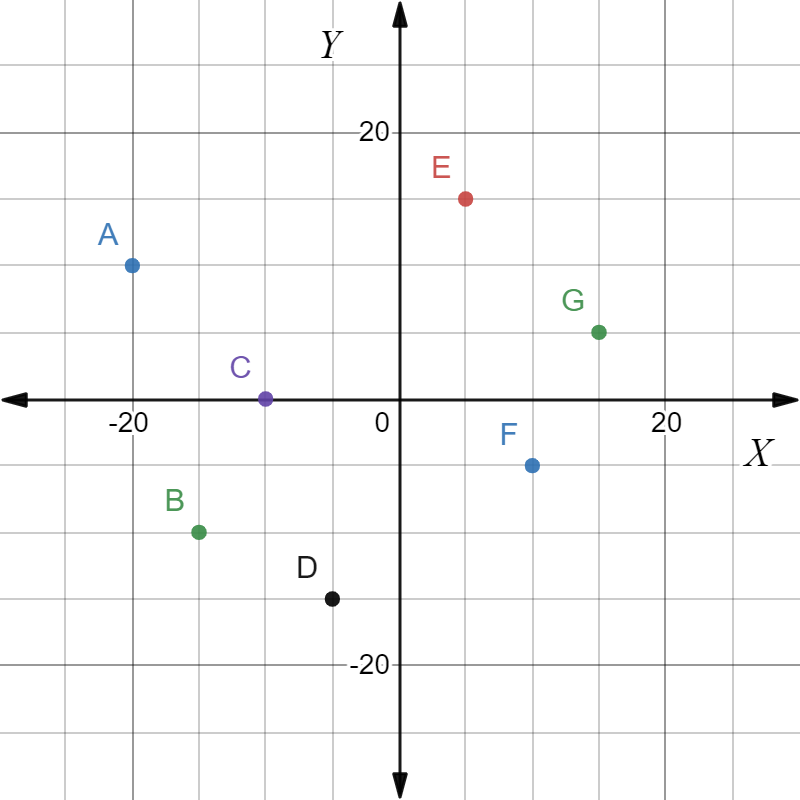
From the graph, the points strictly outside the circle are A,B,C,E,G.
Therefore, the plant that do not get water are A,B,C,E,G.
The plant that do not get water are A,B,C,E,G.
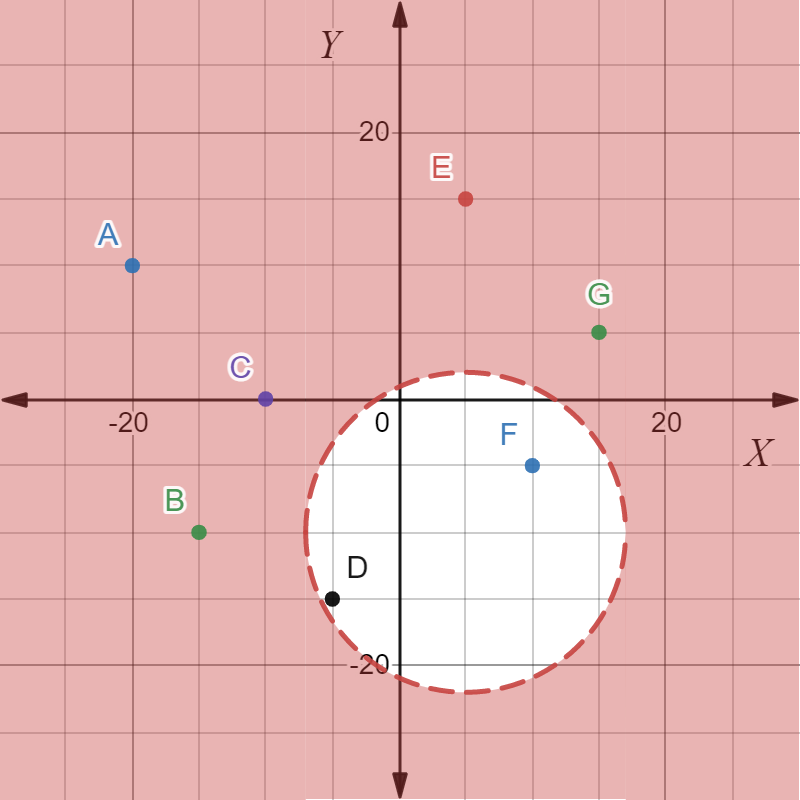
Page 171 Exercise 16 Answer
It is given that two sprinklers are located at the points (5,−10),(10,10) and their range is 12 feet.
The other points are the coordinates of plants.
It is required to determine the plants, which do not get water by writing an inequality and drawing the circles.
Since the plant must be out of the two circles for, use the inequality (x−h)2+(y−k)2>r2.
Then, draw the graph of the circles on a graphing calculator by substituting the coordinates in the equation of a circle. Note down the points that lie outside the circles.
From part (a) of the exercise, the inequality for the sprinkler at (5,−10) is (x−5)2+(y+10)2>122.
For the second inequality, substitute (10,10) for (h,k),12 for r in the inequality (x−h)2+(y−k)2>r2.
(x−10)2+(y−10)2>122.
Plot the graph of the circle with equation (x−5)2+(y+10)2=122 by using a graphical calculator.
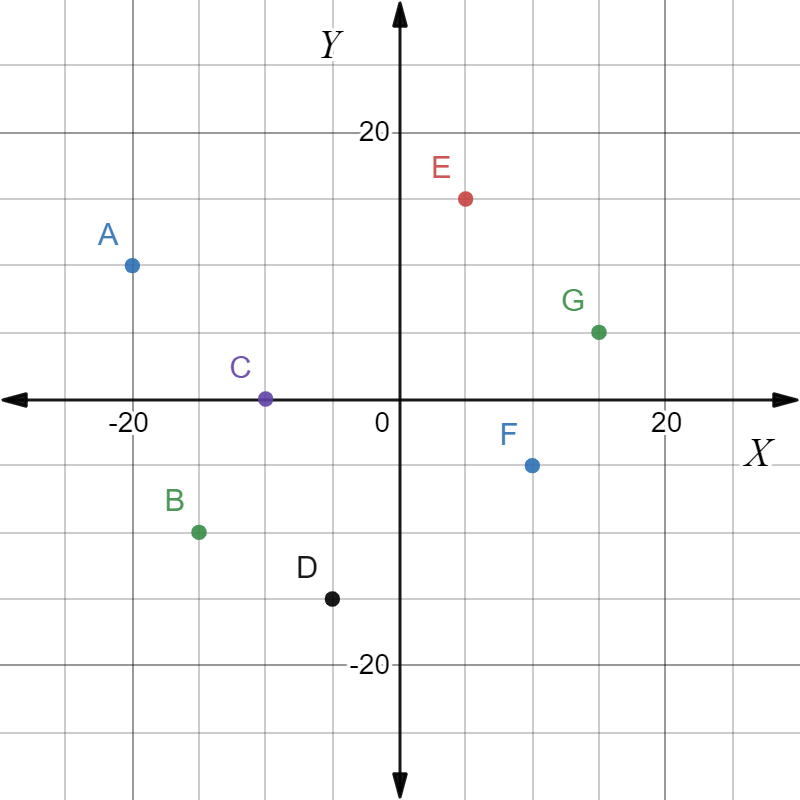
Plot the graph of the circle with equation (x−10)2+(y−10)2=122 by using a graphical calculator
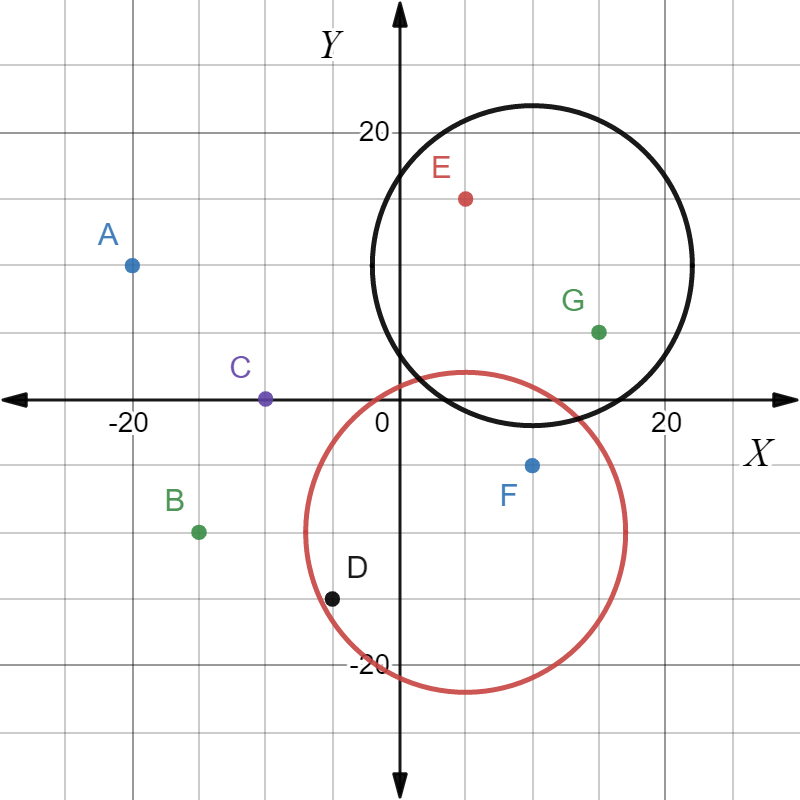
From the graph, the points strictly outside both the circle are A,B,C.
Therefore, the plants that do not get water are A,B,C.
The plants that do not get water are A,B,C.
HMH Algebra 2 Volume 1 1st Edition Module 4 Chapter 4 Exercise 4.1 Quadratic Equations And System Of Equations Page 171 Exercise 17 Answer
It is given that two sprinklers are located at the points (5,−10),(10,10) and their range is 12 feet.
The other points are the coordinates of plants.
It is required to determine the position of the third sprinkler such that all the plants get water and draw the circle for all the three sprinklers.
For third sprinkler choose the point (−15,0).
Substitute the values in the standard form and the plot the graph of the circle. Note that all points should be inside any of the circles.
From part (b) of the exercise, the graph for the two sprinklers is as follows:
For the third circle, substitute (−15,0) for (h,k),12 for r in the equation (x−h)2+(y−k)2=r2.
(x−(−15))2+(y−0)2=122
(x+15)2+y2=122
Plot the graph of the circle with equation (x+15)2+y2=122 in the graph of part (b), by using a graphical calculator.
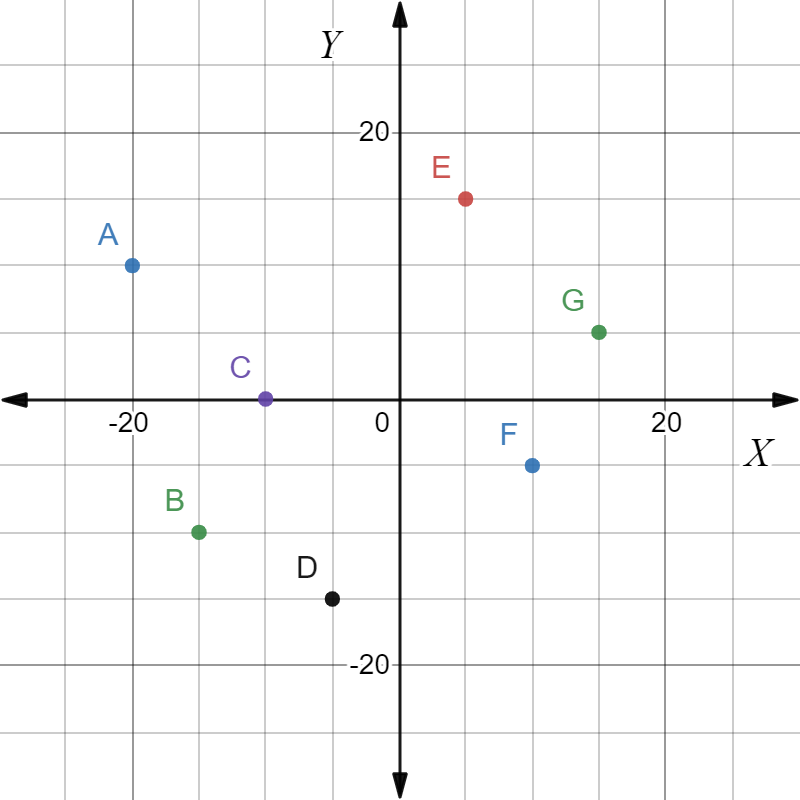
From the graph, it is clear that if the third sprinkler is at the point (−15,0) then all the remaining points are covered.
Therefore, for all the plants to get water the third sprinkler can be placed at (−15,0).

The position of the third sprinkler such that all the remaining plants are watered is (−15,0).
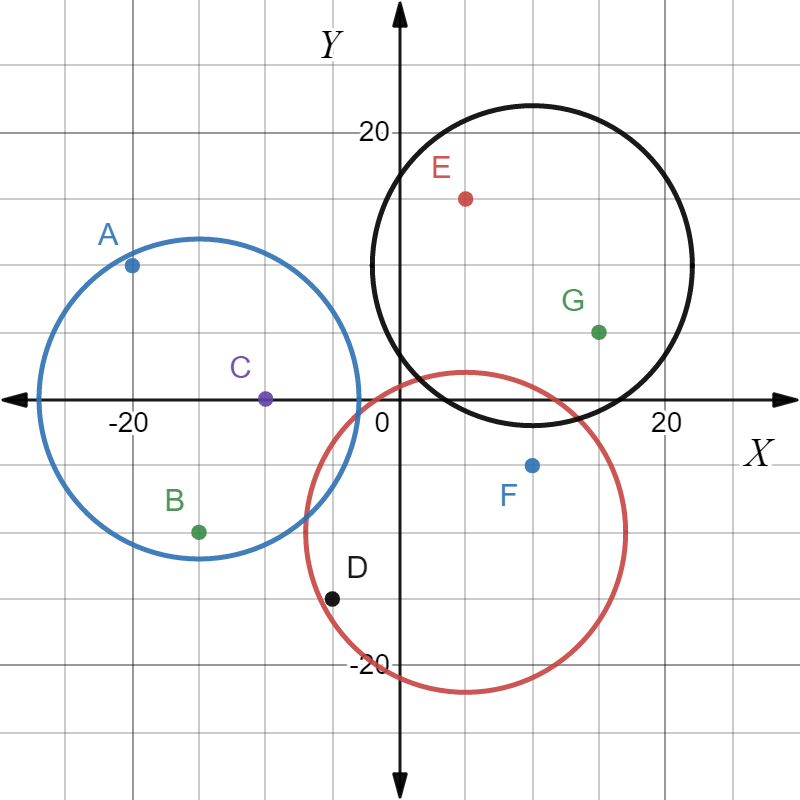
Page 172 Exercise 18 Answer
It is given that the Sun is placed at S(0,0) and the Venus rotates around the Sun in a circular orbit, which passing through V(41,53).
It is required to write the equation for the orbit of Venus and determine the distance between Venus and Sun if each unit in the coordinate plane represents one million miles.
Here, the centre of the circle is S(0,0) and it passes through V(41,53), To find the equation of the orbit, substitute the given values in the formula
(x−h)2+(y−k)2=(x1−h)2+(y1−k)2.
Simplify the equations by using the identity (a+b)2=a2+2ab+b2.
The distance between the Sun and Venus is equal to the radius of the orbit multiplied by the length of each unit in the coordinate plane.
We have to substitute (0,0) for (h,k),(41,53) for (x1,y1) in the inequality (x−h)2+(y−k)2=(x1−h)2+(y1−k)2.
Simplify the equations by using the identity (a+b)2=a2+2ab+b2.
(x−0)2+(y−0)2=(41−0)2+(53−0)2
x2+y2=1681+2809
x2+y2=4490
x2+y2≈672
This means that the radius of the orbit is 67 units.
Therefore, the distance between the Sun and Venus is 67 million miles.
The equation of the orbit of Venus is x2+16x+y2−4y+3=0 and the distance between the Sun and Venus is 67 million miles.
HMH Algebra 2 Exercise 4.1 Systems of Equations answer guide
HMH Algebra 2 Volume 1 1st Edition Module 4 Chapter 4 Exercise 4.1 Quadratic Equations And System Of Equations Page 173 Exercise 19 Answer
It is given that a unit circle is a circle with radius one units and centred at the origin.
It is required to write the equation of a unit circle.
To find the equation of a unit circle, substitute (0,0)
for (h,k),1 for r in the equation (x−h)2+(y−k)2=r2.
Substitute (0,0) for (h,k),1 for r in the equation (x−h)2+(y−k)2=r2 and simplify.
(x−0)2+(y−0)2=12
x2+y2=1
The equation of a unit circle is x2+y2=1.
Page 173 Exercise 20 Answer
It is given that a Pythagorean triple is an ordered triple of three positive integers (a,b,c)
such that a2+b2=c2.
It is required to find two points on the circle in the first quadrant, by using the Pythagorean triple (3,4,5).
Consider the Pythagorean triple (3,4,5) such that c=5.
Here, the radius of the unit circle is c=1.
Therefore, dividing the triples by five, (3/5,4/5,5/5)=(3/5,4/5,1).
This means that the coordinates of a point on the circle in the first quadrant are (3/5,4/5).
Similarly, the triple can be (4/5,3/5,1).
Therefore, the second point on the circle in the first quadrant, with respect to the triple (3,4,5) is (4/5,3/5).
The coordinates of two points on the circle in the first quadrant are (3/5,4/5), and (4/5,3/5).
Page 173 Exercise 21 Answer
It is given that a Pythagorean triple is an ordered triple of three positive integers (a,b,c) such that a2+b2=c2.
It is required to find six other points on the circle in the other three quadrants, by using the result of part (b) of the exercise and symmetry of a circle.
In part (b) of the exercise, the points on the circle in first quadrant are (3/5,4/5),(4/5,3/5).
The relation between the points in second quadrant with respect to points in first quadrant is (x,y)≡(−x,y).
Therefore, two points on the circle, in the second quadrant are (−3/5,4/5), and (−4/5,3/5).
The relation between the points in third quadrant with respect to points in first quadrant is (x,y)≡(−x,−y).
Therefore, two points on the circle, in the third quadrant are (−3/5,−4/5),(−4/5,−3/5).
The relation between the points in fourth quadrant with respect to points in first quadrant is (x,y)≡(x,−y).
Therefore, two points on the circle, in the fourth quadrant are (3/5,−4/5),(4/5,−3/5).
The coordinates of six other points on the circle are (−3/5,4/5),(−4/5,3/5),(−3/5,−4/5),(−4/5,−3/5),(3/5,−4/5),(4/5,−3/5).
Step-by-step solutions for HMH Algebra 2 Module 4 Exercise 4.1
HMH Algebra 2 Volume 1 1st Edition Module 4 Chapter 4 Exercise 4.1 Quadratic Equations And System Of Equations Page 173 Exercise 22 Answer
It is given that a Pythagorean triple is an ordered triple of three positive integers (a,b,c)
such that a2+b2+c2.
It is required to find eight points on the circle by using a Pythagorean triple other then (3,4,5).
(7,24,25) is a Pythagorean triple.
Therefore, the two points on the unit circle in the first quadrant are (7/25,24/25),(24/25,7/25).
Similarly, two points on the unit circle in the second quadrant are (−7/25,24/25),(−24/25,7/25).
Two points on the unit circle in the third quadrant are (−7/25,−24/25),(−24/25,−7/25).
Two points on the unit circle in the fourth quadrant are (7/25,−24/25),(24/25,−7/25).
Eight point on a unit circle with respect to the Pythagorean triple (7,24,25) are (7/25,24/25),(24/25,7/25),(−24/25,7/25)(−7/25,24/25),(−7/25,−24/25),(−24/25,−7/25),(7/25,−24/25),(24/25,−7/25)
Page 174 Exercise 23 Answer
It is given that a highway runs straight east-west and is at a distance of 6 miles from a radio tower, whose broadcast range is 10 miles.
It is required to find the length of the highway for which the car will be in the range of the broadcast.
To find the length of the highway for the mentioned case, use the Pythagoras theorem.
Substitute 6 for a, 10 for c in the formula c2=a2+b2.
Simplify and solve for b. Here, b is the half of the required length of the highway.
Then, multiply the value of b by two.
We have to substitute 6 for a, 10 for c in the formula a2+b2=c2.
Simplify and solve for b.
62+b2=102
36+b2=100
b2=100−36
b2=64
b=8
Multiply 8 by 2.
2×8=16
Therefore, the length of the highway for which the car will get the signal of the tower is 16 miles.
The length of the highway for which the car will get the signal of the tower is 16 miles.
Page 17 Exercise 24 Answer
It is given that a highway runs straight east-west and is at a distance of 6 miles from a radio tower, whose broadcast range is 10 miles.
The car is travelling at a constant speed of 60 miles per hour.
It is required to find the amount of time the car is within the range of the signal.
From part (a) of the exercise, the distance for which the car is within the range of the signal is 16 miles.
Then, use the formula for calculating time when the constant speed and distance covered are known.
We have to substitute 60 for v, 16 for d in the formula t=d/v.
Simplify the expression by using division.
t=60/16
t=3.75
The amount of time the car is within the range of the signal is 3.75 hours.
